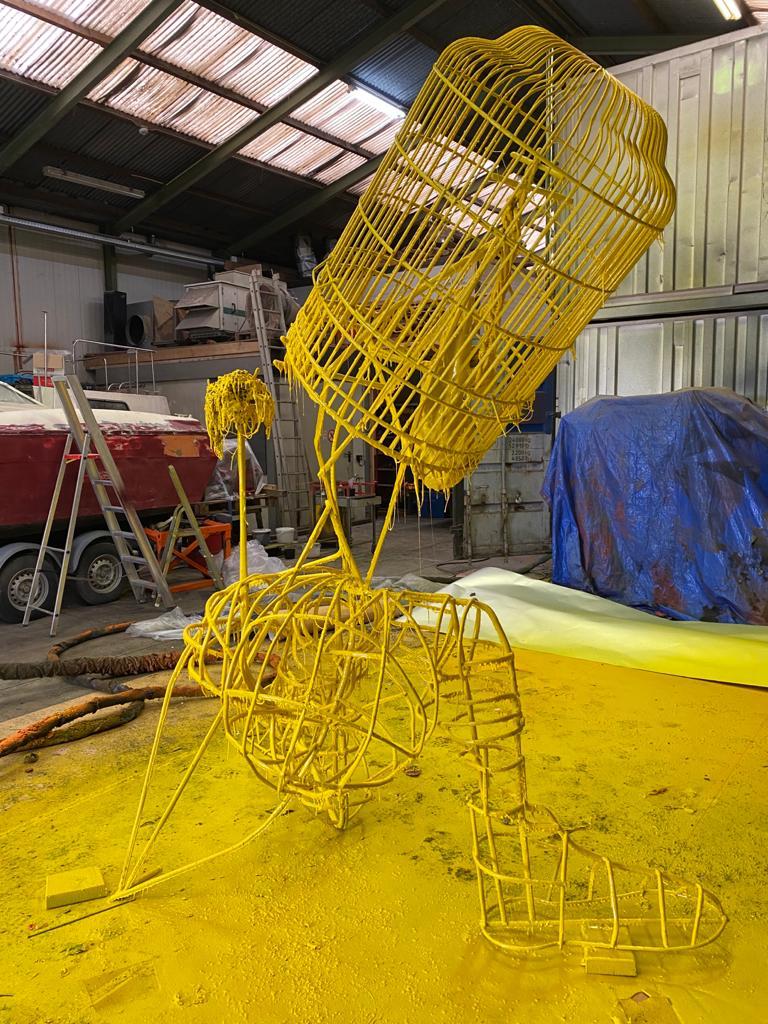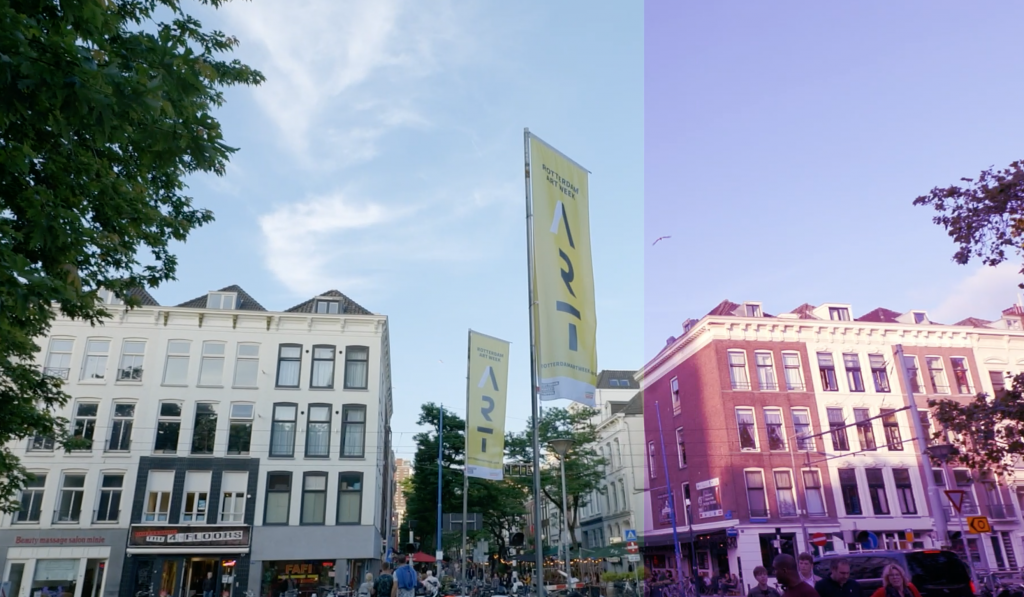
Coming soon
Coming soon
Select type

During Rotterdam Art Week (18 to 22 May), art, design and architecture are placed on a pedestal. With about 70 events at 50 locations, you get a chance to rediscover what makes Rotterdam so unique. Like every year, the pivotal event of Rotterdam Art Week is the international art fair Art Rotterdam, supplemented by the leading design fair Object Rotterdam, young talent at The New Current, the Kunstavond XL in the Witte de Withstraat and the TEC ART festival; at the exciting event at the intersection of art, creative technology and science. In addition, there is a lot to see in the galleries, open studios and unique creative breeding grounds such as STEUR, which are only open to the public once a year. In addition to these must-sees, we highlight a few more tips below.
Charlotte Nijsten, coordinator of Rotterdam Art Week: “The best aspect of Rotterdam Art Week? The whole city is buzzing! That is the result of approximately 70 events at 50 locations, including various fairs like contemporary art fair Art Rotterdam and design fair Object Rotterdam, as well as special openings and exhibitions in museums and art institutions, pop-up exhibitions and open studios that actively enhance and enliven the art climate in the city.”
Tip: did you know that during Rotterdam Art Week, you can borrow a VanMoof e-bike (for free) between 11 am and 5 pm? Please note: It is necessary to make a reservation in advance. In addition, there is a free MINI shuttle service between the Van Nelle factory and the Merwe-Vierhaven area.
Do It Yourself Routes
Do you prefer to go out on your own but don’t know where to start? Then make use of the handy Do It Yourself Routes, which were created in collaboration with Art Index Rotterdam and her tour partner. The walking routes cover the five focus areas: the Merwe-Vierhaven area (M4H), the Van Nelle Factory area, the Kop Van Zuid, the Museum Park and the vicinity of the Central Station. View all walking routes here. Tip: click on the Google Maps button on the website to open the route (including all locations in Google Maps) on your phone. That way you can effortlessly navigate through the city.
Vriend van Bavink | Teun Castelein
The Totem project by artist Teun Castelein is a response to the far-reaching regulation of our public domain with a multitude of rules and instructions. The project is an experimental research to find some space for the artistic within our controlled environment, for some free jazz on the beaten track.
The series of traffic signs will be placed in your street after purchase. Plates can also be ordered separately.
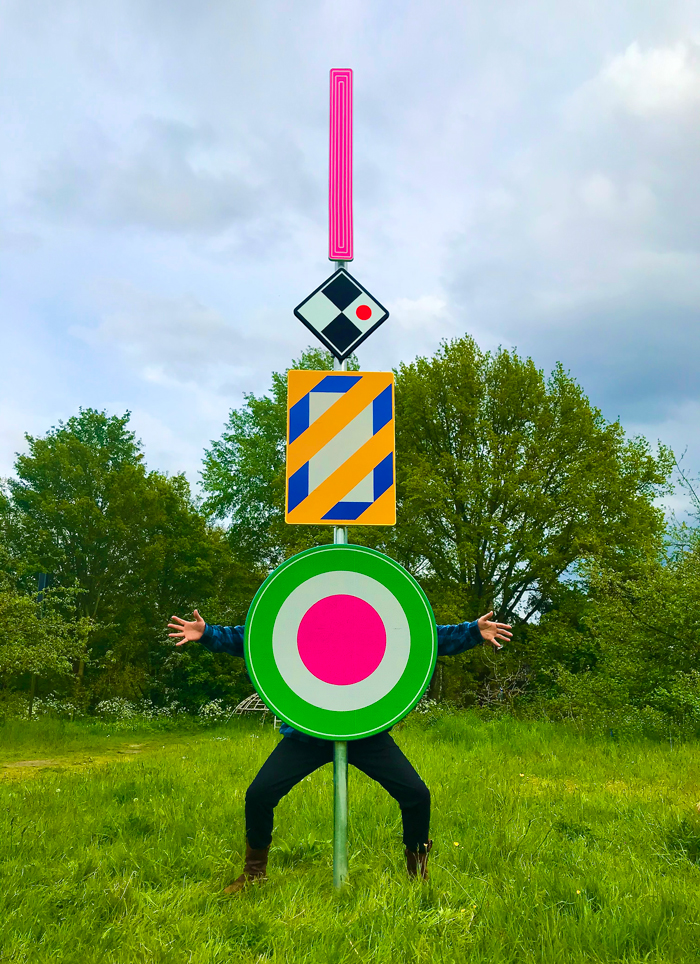
Martin van Zomeren | Paul Geelen
Mothership (…) is a large suspended ceramic sculpture that accumulates over a stretched period of time and descends from an immediate fusion between a series of contradictions and imbalances; an anecdote and the visual associations between a Snail Shell and the mutations of the hair on the Buddha’s Head and Uṣṇīṣa.
In addition to the direct impact – or by rapprochement, some closer tensions between formal, abstract and semantic associations – the ‘performative’ presence of living snails on the two bodies is characterized by a chemical reaction between the bronze glaze and the soft body of the snail.
These traces – leaving an iridescent etching effect and a permanent mark – reveal a colourful potential and transform the snail from a temporary bit player into a humble protagonist, protector and martyr at the same time.
Note: A snail is able to naturally adapt and protect itself against more severe conditions.
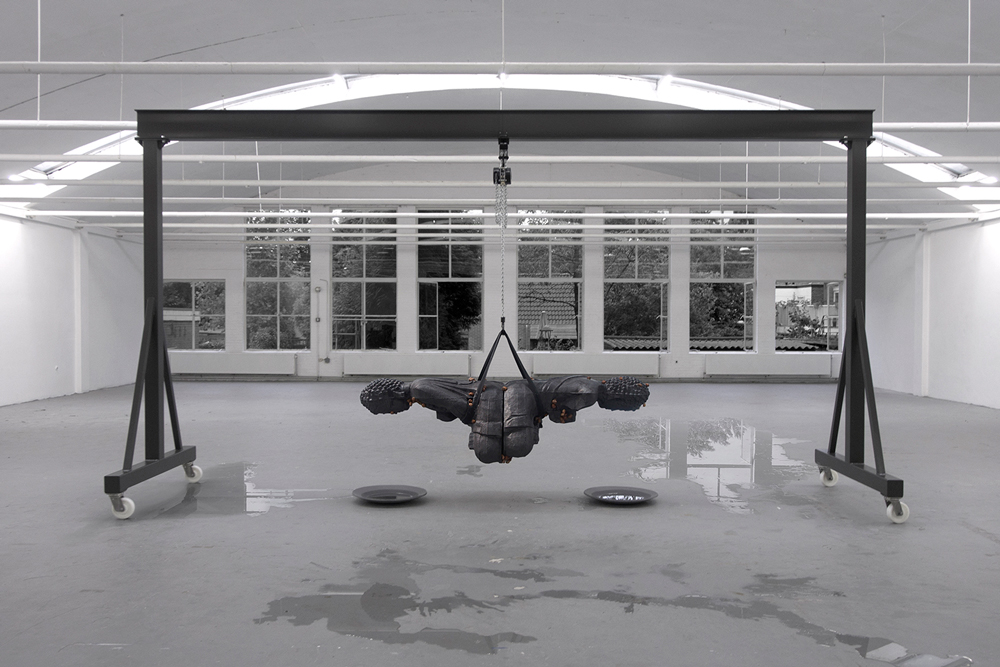
Mondriaan Fonds| Wiebe Bouwsema
For Wiebe Bouwsema, boundaries or limitations are a recurring theme: between the material and the immaterial, between interior and exterior spaces, between the actual and the virtual worlds and between man and nature. He brings these contradictions together in his work, allowing them to flow into one another, cancelling them out as well as emphasizing them. You can see it as oppressive, as dark, but also as quiet and poetic, as figures who – like Michelangelo’s Prisoners – still have to free themselves from their material.
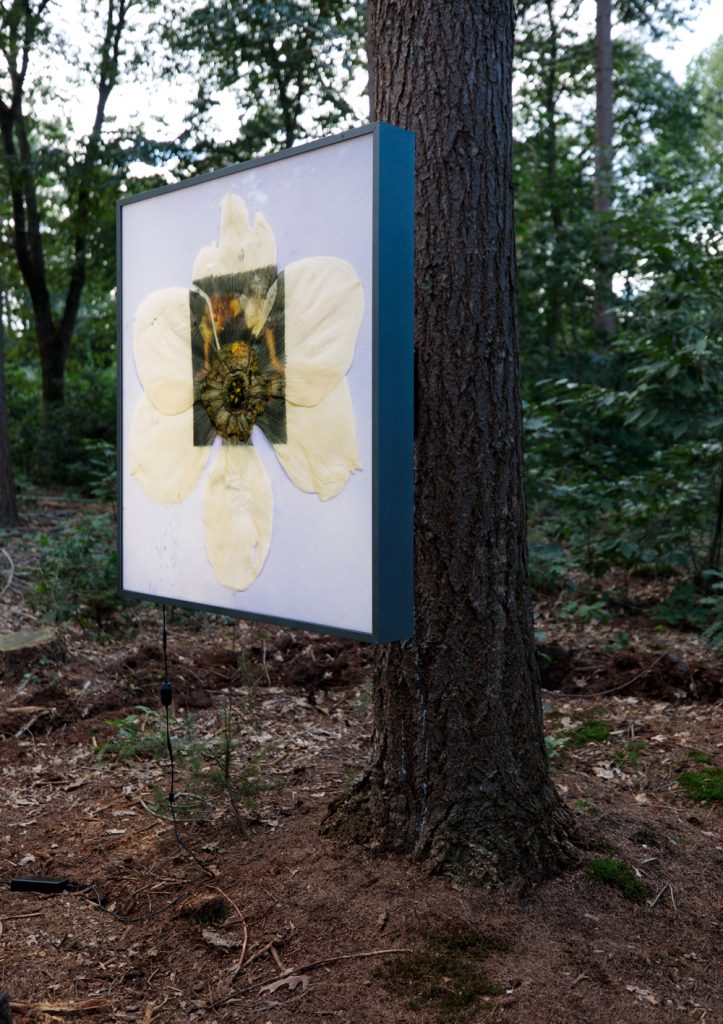
Opperclaes | Onno Poiesz
The blues
With the blues, Onno Poiesz welcomes the public. The work is meant to be festive, but is also a reference to war and pandemic, or contemporary “blues” that dominate the beginning of 2022.
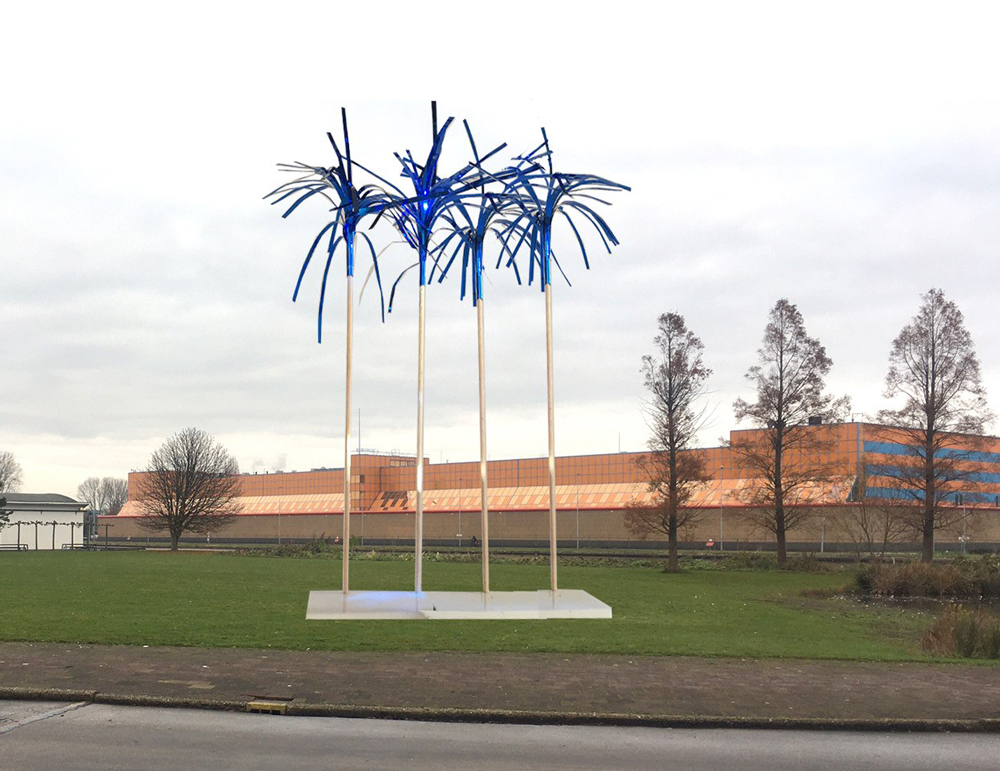
NEST | Eugenie Boon
The Pawns that Wandered in Promised Land is an installation which creates an analogy between the physical and the spiritual, fused by references of Hebrew literature, philosophy and boardgames.
“The Promised Land” in Hebrew literature expresses an image of a restored homeland that brings salvation and liberation and is understood as a goal to be reached. With this work Boon suggests that the Promised land is not only a physical place but can be understood as a state of mind- with the brain as the main battlefield, figuratively represented as a board game and the pawns as either reactive or proactive in their approach to this understanding.
With this installation Boon reflects on what can be seen and experienced versus that which cannot be seen yet still experienced. The experience is constant while the components around change through visualization.
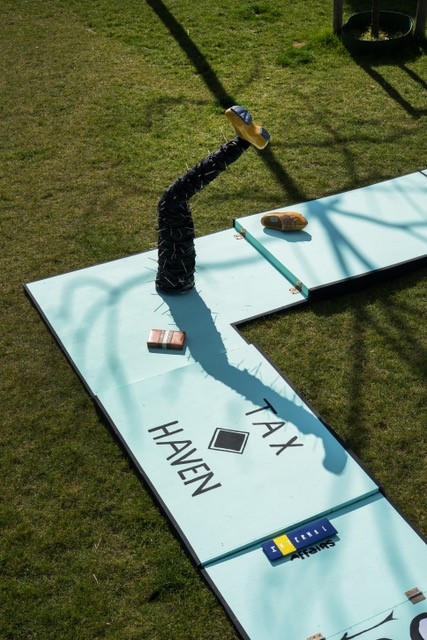
Josilda da Conceição | Bernardus Baldus
In my work I investigate the power and influence of corporate language and visual culture and its disciplining effect on society. A culture where everything can be made and controlled on the basis of figures and efficiency. I am inspired by things like efficiency, success and manufacturability, entrepreneurship, positivity, transparency, office architecture and office supplies. This leads to business objects (sculptures), performances, drawings or photos that function as illusions (simulacrum or simulation). I find it stimulating that the symbolic value – such as luxury and/or status – is more important than originality and authenticity. As an artist, I myself consider originality to be a meaningless, empty concept. Baudrillard calls this the ‘irony of the object’.
In my work I use irony as an ambiguous game with which I can seduce, surprise or make the viewer doubt. The most exciting thing about irony is that it functions through the unsaid judgment. To understand irony, context and foreknowledge are important to understand that which is not spoken. If, through irony, I ask the viewer to understand that there is a moral judgment in my work, then both the viewer and I must share that judgment in order to understand the unspoken. That does not always work.
With my ironic, critical work I want to stretch the line between what people expect from art and what it is now. The context and/or prior knowledge of the spectator are important aspects here.
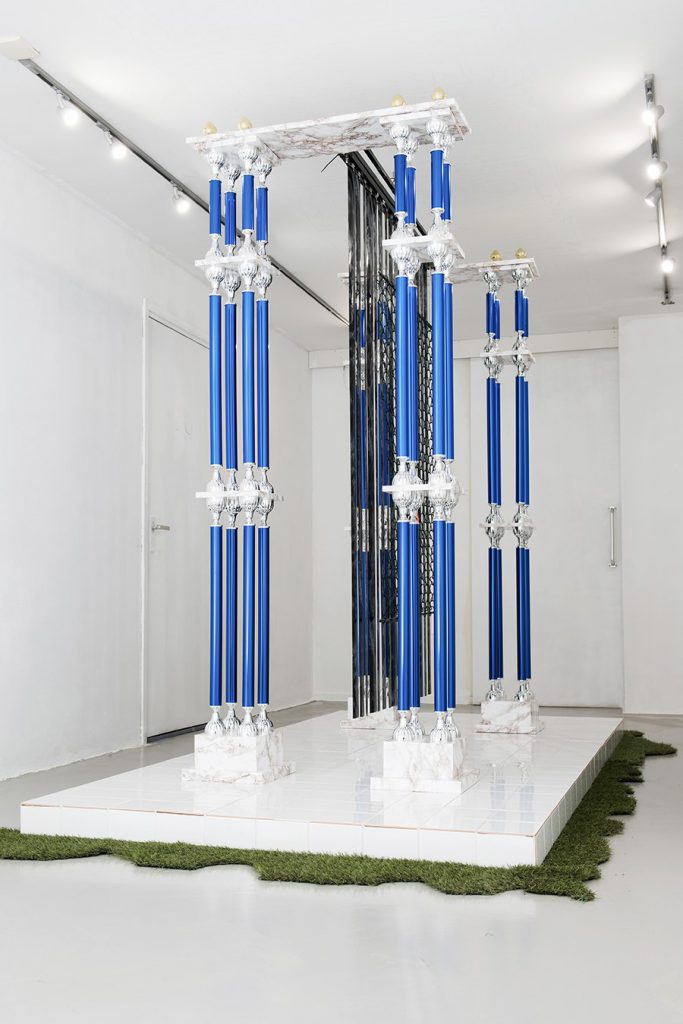
Josilda da Conceição | Marjolein Witte
Seduction is a sculpture that is a follow-up to the Evolution sculpture Witte made in 2019 for the exhibition Masterly Women at Stedelijk Museum Schiedam. By making robust, bold and strikingly colored geometric constructions, Witte investigates how we as a group or individual claim space and try to bend the world to our will. The need to be seen is at the core of our existence. We seek confirmation of our identity in family, in relationships, at work, in society and in the world. As happens similar to the animal kingdom, people have come up with all kind of ways to stand out and claim a place with different sensory means. On a micro level, here it is the artist who spreads her feathers like a bird in an attempt to seduce the viewer.
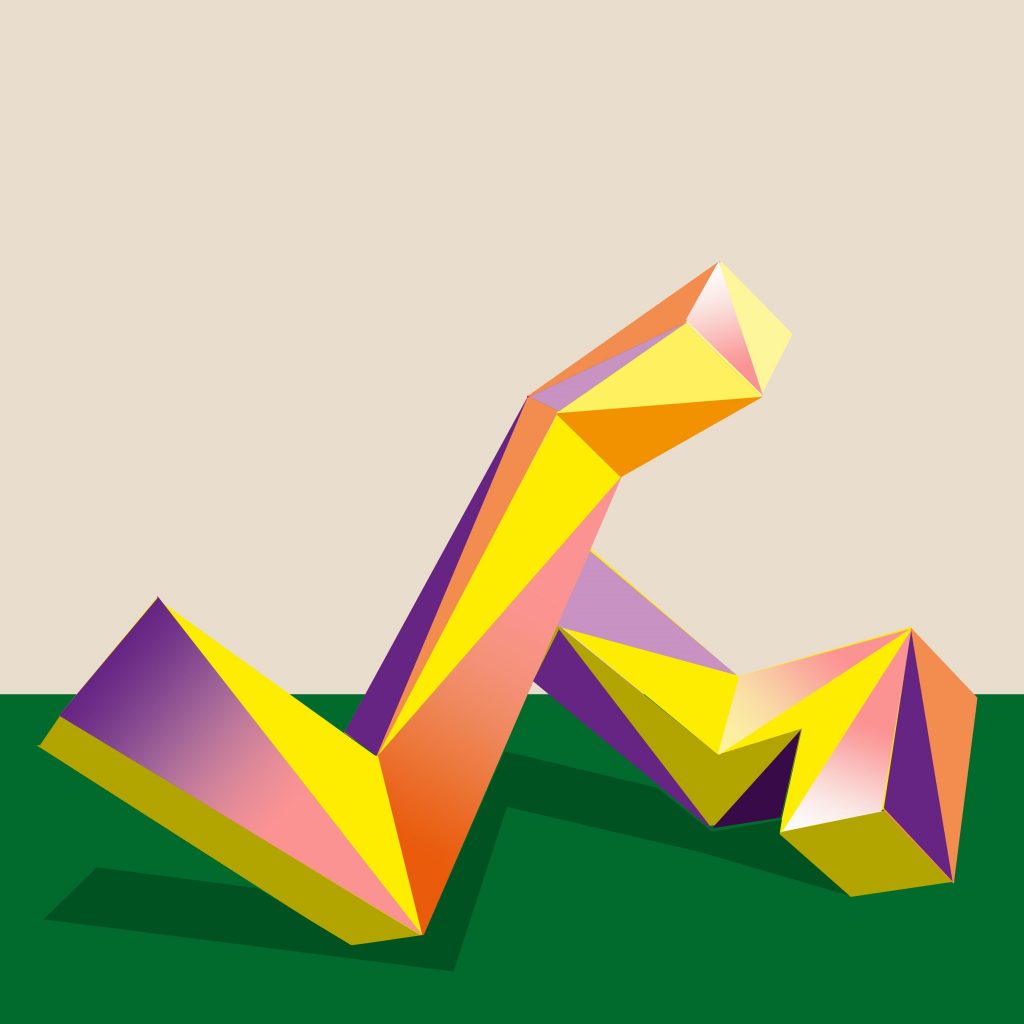
Galerie Nadja Vilenne | Charlotte Lagro
Charlotte Lagro takes found objects and relieves them of their intended purpose and function to accommodate new possibilities for exchange and desire. She strips them bare, plays with them and transforms them, and makes videos about them, often inviting others to join in the process. With sleight of hand, Lagro can make heavy objects appear almost weightless. The work “The Beginning and Ending is Always Ambiguous” centers around an umbilical cable used to supply oxygen, as well as light and communication signals, to deep sea divers. From a hundred meters below, divers climb the umbilical, hand over hand, to make their way back to the surface. In water, its air-filled tubes have just the right amount of added mass to gently sink. This artificial lifeline materializes the vulnerability of human existence. And the search for the familiar in the unfamiliar with handcrafted extensions. An optimistic relic of the human endeavor to the leave the bubble.
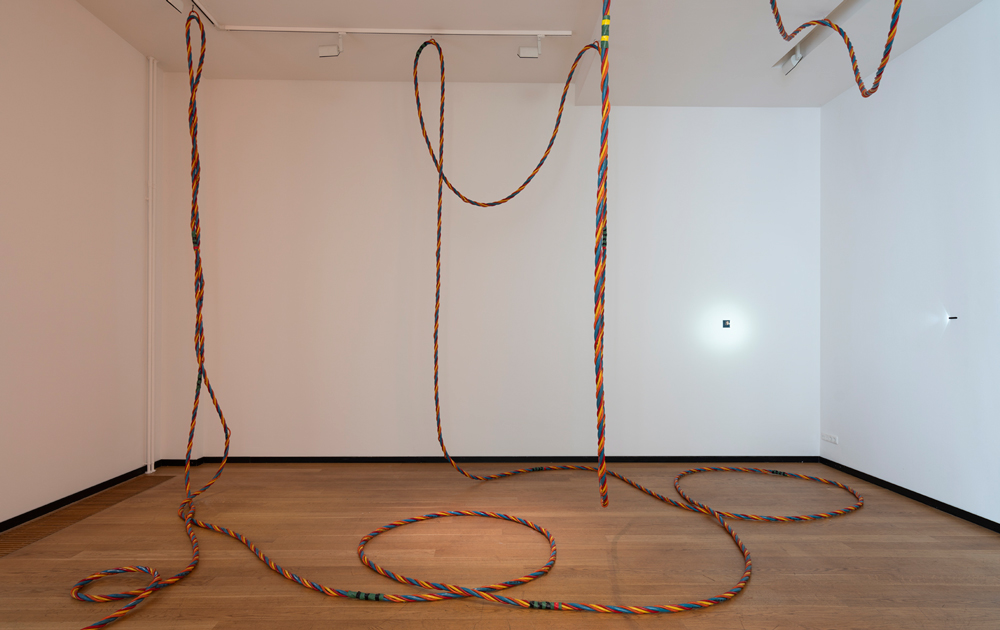
PHOEBUS Rotterdam | Esther Bruggink
I would like to escape from the watery depths, to become human and live in the golden sunshine! – this is what the little mermaid from Andersen’s fairy tale sings, in Dvorak’s opera “Rusalka”. In her longing for the prince, she sacrifices her voice and with it her ‘uniqueness’. She loses herself in vulnerability and the prince has to let her go… Full of sorrow she dissolves in the foam of the sea. The sculpture shows a structure of veins and scales, while the lungs on Rusalka’s back refer to angel wings…
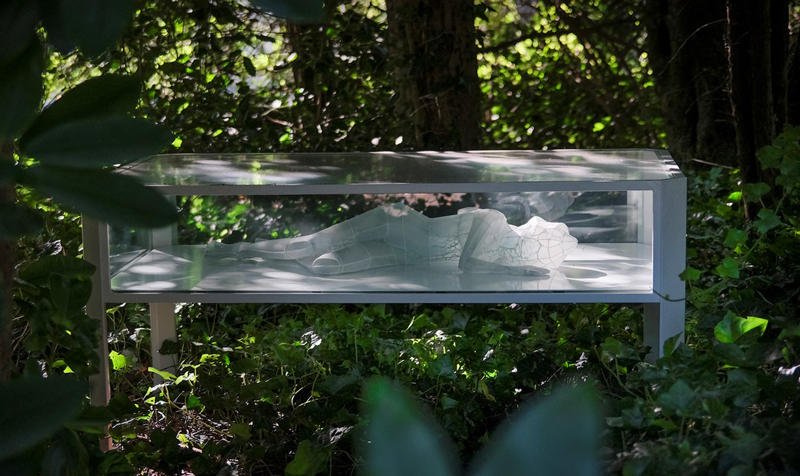
Winterlicht Schiedam | Leonard Passchier
Alarm!
UV light is essential for all living organisms on earth, but it also makes capital grow. In Rotterdam’s backyard, the Westland, you can see the purple-blue LED UV lights lighting up more and more often. Will artificial light be our future? Will we no longer be able to live without it? Will it be our only way of getting the vitamin D we need in a world where artificiality is becoming increasingly important?
Passchier’s beacon screams for attention. It’s five minutes to midnight and our climate is changing rapidly. Is this beacon warning us of rising water? Can we trust this beacon, can we navigate on it? Or will we suffer the fate of flies and mosquitoes that get too close to UV light and burn up?
In December 2022, the beacon will be part of the Winterlicht light art festival in Schiedam, which will take place in the Julianapark.
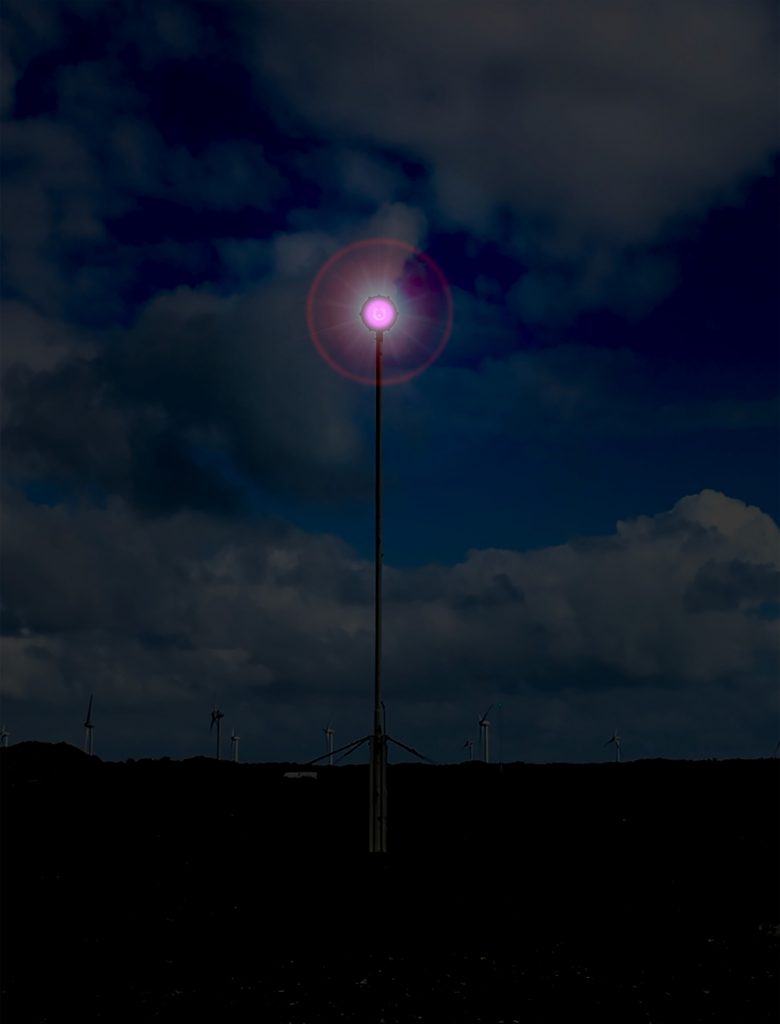
Jaap Sleper | V&B (Alex Jacobs en Ellemieke Schoenmaker)
Over millions of years, our world has been shaped by various geological processes. I would like to introduce you to ‘Continental Drifter no.3’, the promoter of this long forgotten history.
Stones are very sensitive to their environment and especially to vibrations. This sensibility has an effect on their surface.
My appearance is cuddly. This is because I consist of many layers of colored plaster that have been sanded until my skin feels polished. Where necessary I have been restored and drawing has been applied to come as close as possible to a feeling:
‘What would it feel like to be a rock; what was it like when dinosaurs walked the earth. Stones may not be able to speak, but they are telling us something and we need to listen. Because, even though we don’t know much about existence beyond humans, we can still try to imagine it….‘
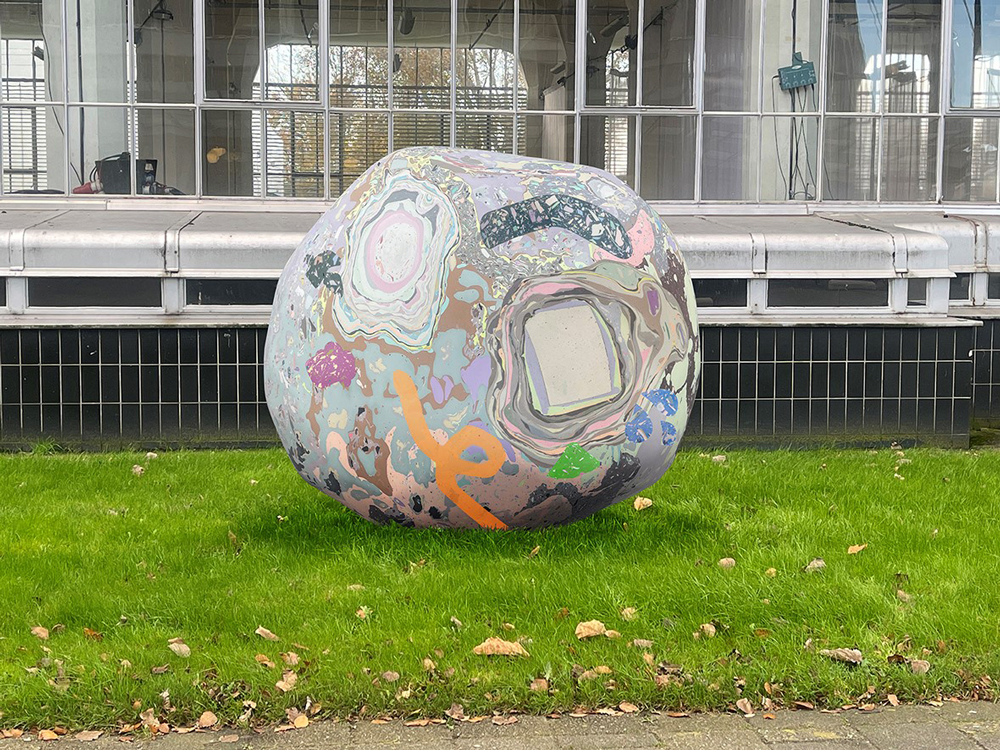
Albada Jelgersma | Jelle Koorevaar
A populist creates his own image of the world, together with his followers. Together they create their own truth within reality. There is an interdependency. Without his followers the populist is nothing. But being part of this worldview is what gives followers a sense of belonging. Populism shows this interaction between a central figure and his followers. In a very large spiderlike web a machine is hung. From a central point, the machine and the web together create a movement that spreads out. Both are dependent on each other. Without the machine the web hangs still. Without the web, the movement would just be inside the machine. Ultimately, it’s unclear who is in control.
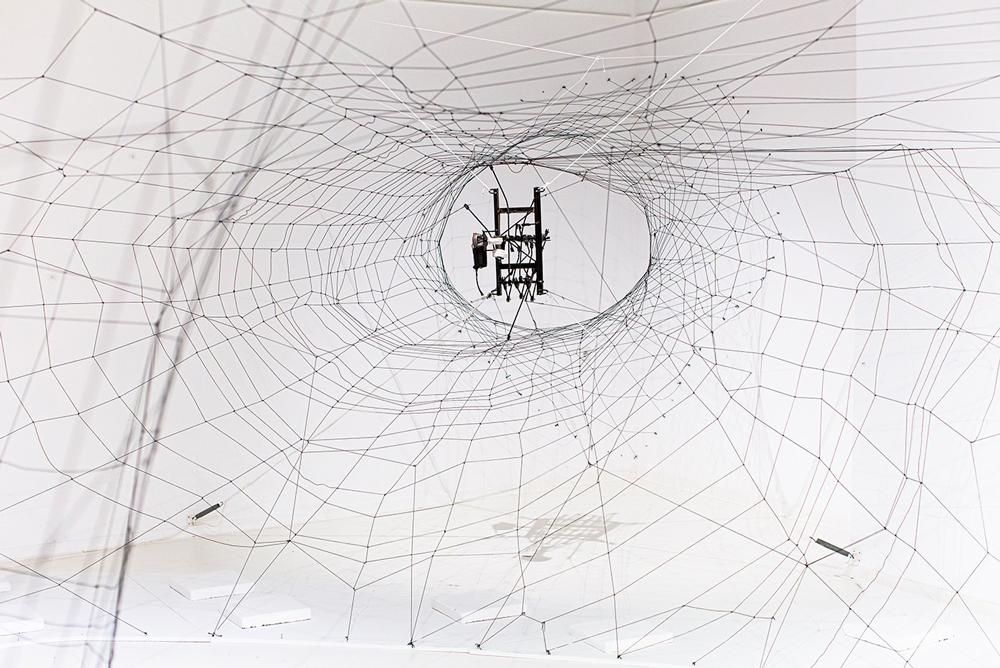
Mundriaan Fund| Roosje Verschoor
An investigation into the phenomenon of hoarding led Roosje Verschoor back to World War I and the food shortages that so prevailed among the poor in Dutch cities. The Amsterdam Potato Riot took place at that time and forms the foundation for this work. Verschoor hands out small, pointed paper bags of fries from a traditional chip cart, an action that refers to a period when potatoes were rationed. At the same time, the snack refers to the ‘spoiled fries generation’, as Verschoor and her peers are called.On the chip bags is a QR code that links to a digital chart in which we can follow how and where the riot unfolded in Amsterdam. In this Boezelaarskompas, named after the aprons worn by the women, archival material and fiction have been brought together. Verschoor has also incorporated archival materials into collages on paper made of potato peels. The final part of this investigation into the Netherlands’ best-known popular food is a series of precious bronze potatoes.
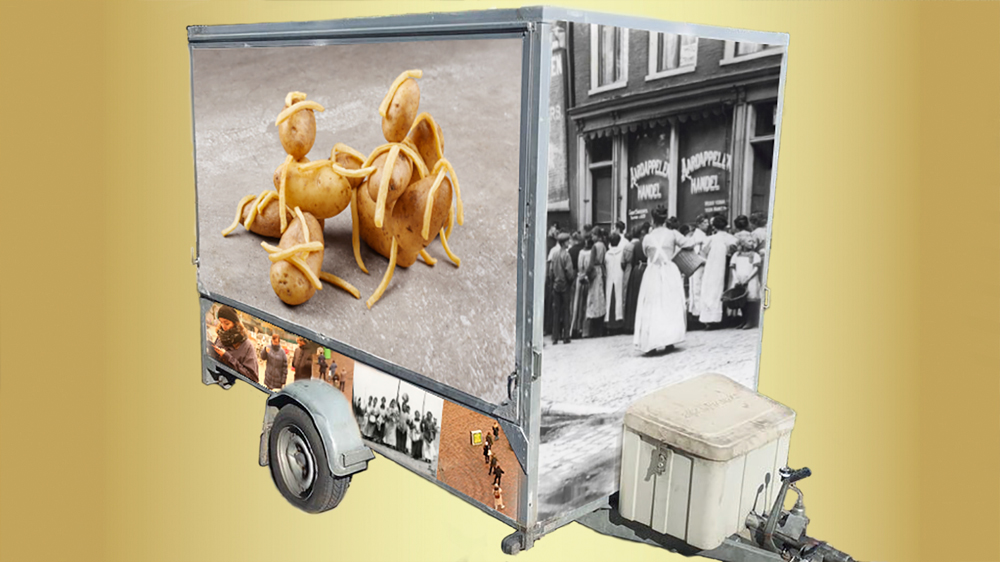
Mondriaan Fund | Jonathan Straatman
Jonathan Straatman makes architectural installations, sculptures with interiors as well as exteriors. Here, the emphasis is on how the interior space is experienced. His architectural assemblages are a kind of ‘mind map’, translations of ideas and concepts about spaces that can be walked through. In this work as well, the way in which we move through the installation plays an important role. The work is about our urge and desire to hold on to and comprehend a reality. At the heart of the experience awaits a soundscape by Twan Bracco Gartner, made especially for this sculpture.
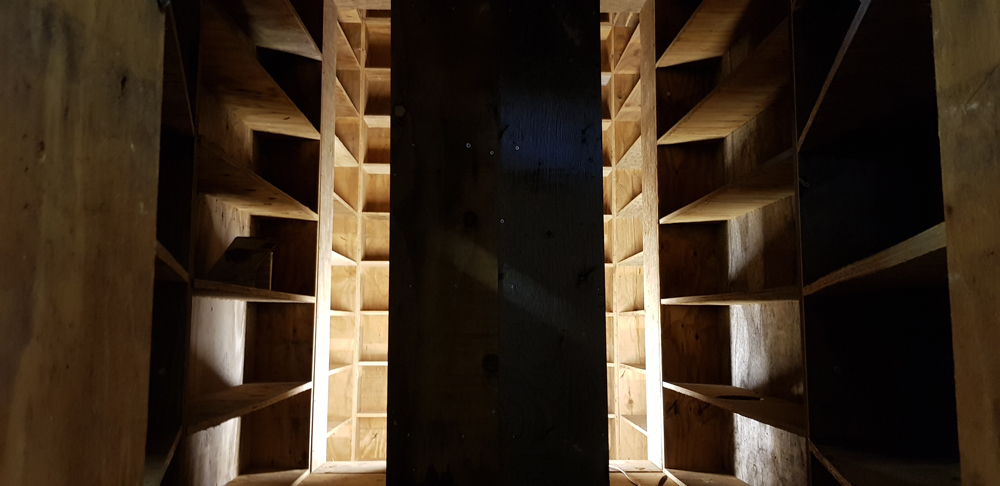
Trendbeheer | Toine Dutch Bushman Klaassen
Not For Sale is a living installation. Contemporary archeology in a laboratory of make-believe: generatio spontanea, visual chemistrymix.
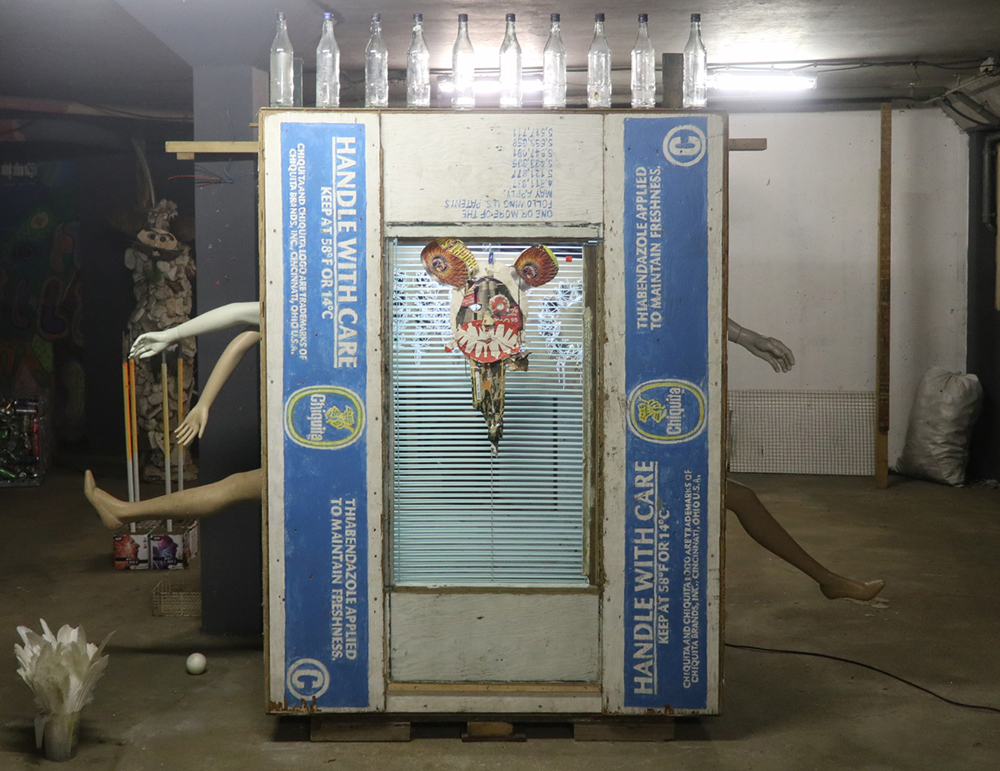
Lumen Travo Gallery | Thierry Oussou
The flag “Equilibrium Wind” is part of the on-going project that artist Thierry Oussou has developed in recent years, addressing the cotton plantations located in the district of Panouignan in Benin and the significant impact they have on the country’s economic growth.
Cotton is an important African product in the globalized arena. It is featured in international discourses and debates on privatisation, poverty alleviation, agricultural subsidies, and sustainable development. But unlike gold or oil, cotton grows from the efforts and sweat of millions of small‐scale farmers, with households and entire communities depending on it.
This flag represents all the people working in the shadows. It is a symbol for the farmers that work hard and are not seen in our society. Oussou re-connects the dots of cotton manufacturing, pointing out the sequence of actions that we, as consumers, often forget about.

Tim Wes
“This is my best body of work until date”, says Wes. As his delicate taste for cultural blending and ability to challenge the status quo of the universal perception of art, gave life to a genre bending artistry, the proverbial energy that flows through his creations reflect the disruptive-healing vision he has for the world. In his latest work he shows us the term uomo universale, today also referred to as a multidisciplinary artist, still exists. Just as Da Vinci embodied this in the 15th century, the Rotterdam based creator redefines the definition of this term by establishing unprecedented innovations in the contemporary fields. A blueprint for the new order. With the installation Trauma Triggers Triumph he uses film, music, canvas and objects to narrate his story and that of many others.
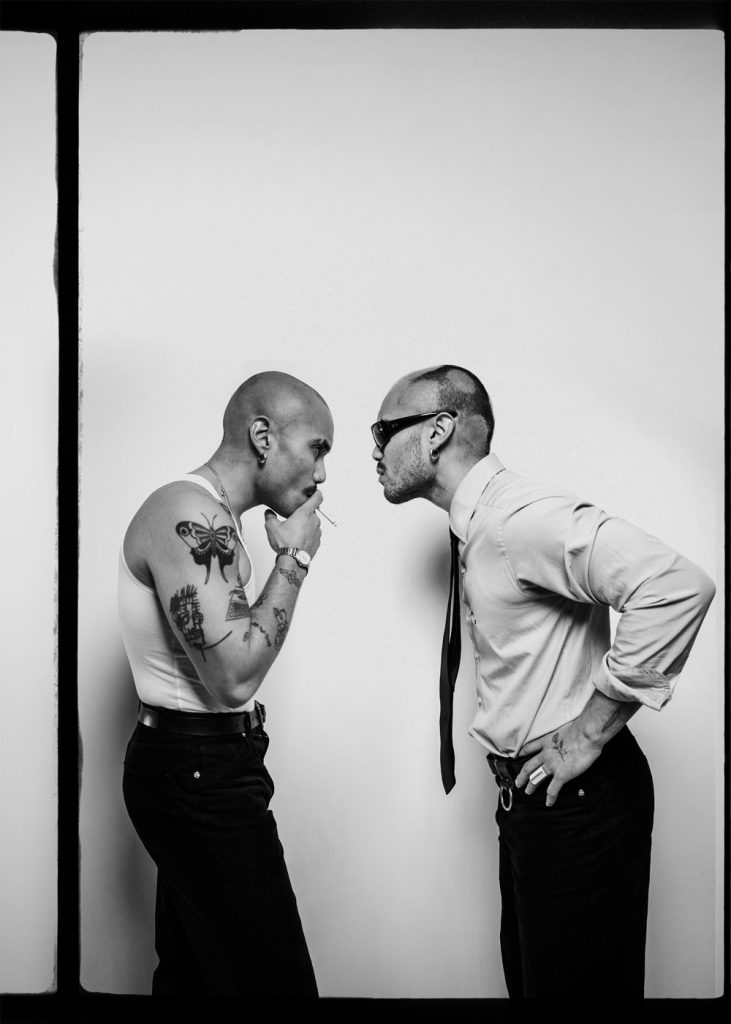
During Art Rotterdam, you can spot the work of hundreds of artists from all over the world. In this series we highlight a number of artists who will show remarkable work during the fair.
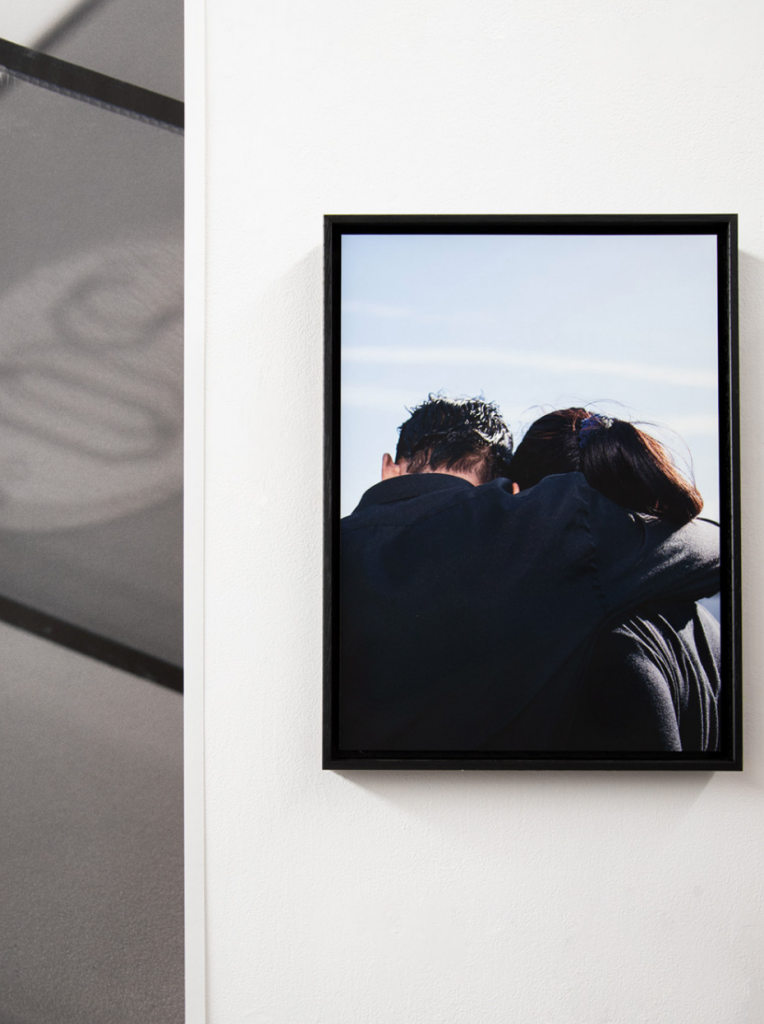
From a young age, the Polish-Dutch photographer Wiosna van Bon was extremely interested in how other people live. When she was six years old, she regularly walked to school alone, because her mother worked in nursery homes and her father usually worked several jobs at the same time. She would leave the house fifteen minutes earlier and then ring the doorbell at random houses on the way, asking if she could come in for a while. After a few months, these astonished neighbours would ring the doorbell at the six-year-old’s house; they appreciated the social calls, but perhaps not at a quarter to eight in the morning. It is a telling sign for the photographer’s curiosity, a curiosity that is strongly reflected in her work. During the same period, she also got her first analog camera, stimulated by her mother, who had a creative background and had completed a university degree in Poland. Van Bon’s father died at a young age, when the photographer was just twelve years old. It’s perhaps not surprising, then, that she has such a deep-rooted interest in the ways in which different family units function.
Van Bon studied documentary photography at the Royal Academy of Art in The Hague, but always retained an interested in psychology. She enjoys reading books by the British neurologist Oliver Sacks for instance, whose works offer a glimpse into the human mind. Van Bon actually does the same thing: she seeks out a niche social group and then tries to interpret them, to really understand them. When she accompanied her mother to the care facility where she worked, the photographer was fascinated by subtle differences. She noted how in some of the older homes, there was usually much more room for the individuality of the residents.
Later, she photographed people who claim to be hypersensitive to electromagnetic radiation, the predecessors of the people who are now firmly convinced of the possible damage of 5G. It’s always based on a genuine interest in their experience and combined with extensive research. For this project, she also entered into discussions with various experts, organisations and the people in question. She often spends months working on a project, which gives her a really good picture of the lives of these people. Van Bon noticed that she was sometimes confronted with her own conscious or unconscious prejudices and she hopes to encourage her viewers to look at these groups of people with a fresh perspective as well.
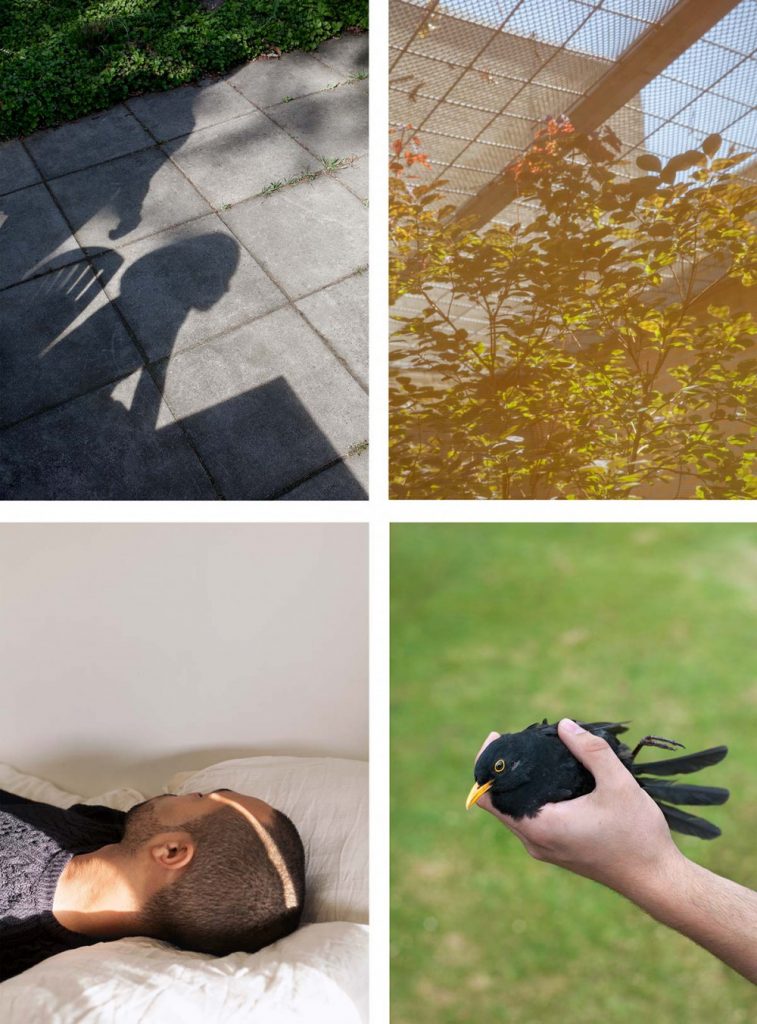
The photographer’s most eye-catching project is probably ‘Family Stranger’, which was published in 2020 in a photo book of the same name. In it, she puts the lens on relatives of detainees, who often feel judged by society. In a combination of images and quotes, she captures an underexposed narrative: how does your life change when a family member goes to prison? What does it mean to be an indirect victim of their actions? Family members will sometimes find themselves in financial trouble or are judged by those around them. A strange situation arises in which the prisoner ends up in a kind of time capsule where time seems to stands still, while the lives of their loved ones continue as usual. The series shows a glimpse of the interior of the Penitentiary Institution Vught, in combination with unrecognisable family members. Van Bon works in metaphors and symbols and depicts, among other things, shadows of bars, an inner courtyard, a clock or toys. Van Bon focuses on the (temporary) loss, the shame and vulnerability of these families, as well as the taboo that seems to overshadow everything. But at the same time, she also emphasises their humanity, strength, flexibility and perseverance. The photo book ‘Family Stranger’ was shortlisted for the Aperture First Book Award and The Author Book Award during the photography festival Les Rencontres d’Arles, among others. For a new series, the photographer focuses on homeless young people. What all of these diverse groups have in common is that they contain extremely lonely people, groups that are to some extent isolated from society. Van Bon looks at their lives and considers themes like power, behaviour and identity.
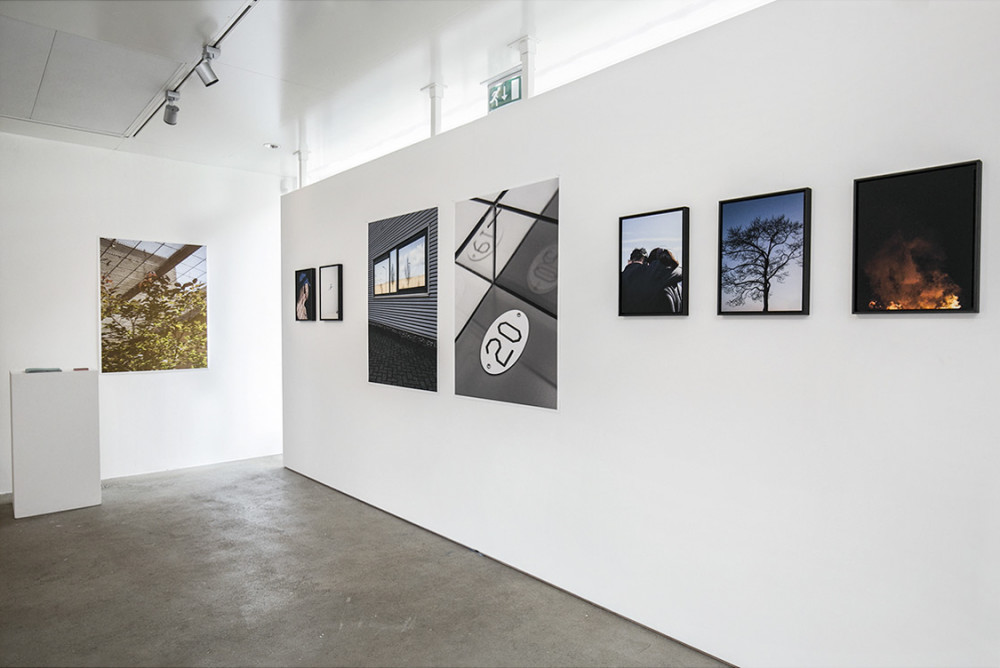
During Art Rotterdam, the work of Wiosna van Bon will be on show in the Prospects exhibition of the Mondriaan Fund. For the 10th time in a row, the Mondriaan Fund presents the work of 88 emerging artists here. In 2020, all of these artists received a financial contribution from the Mondriaan Fund to make a start in their career.
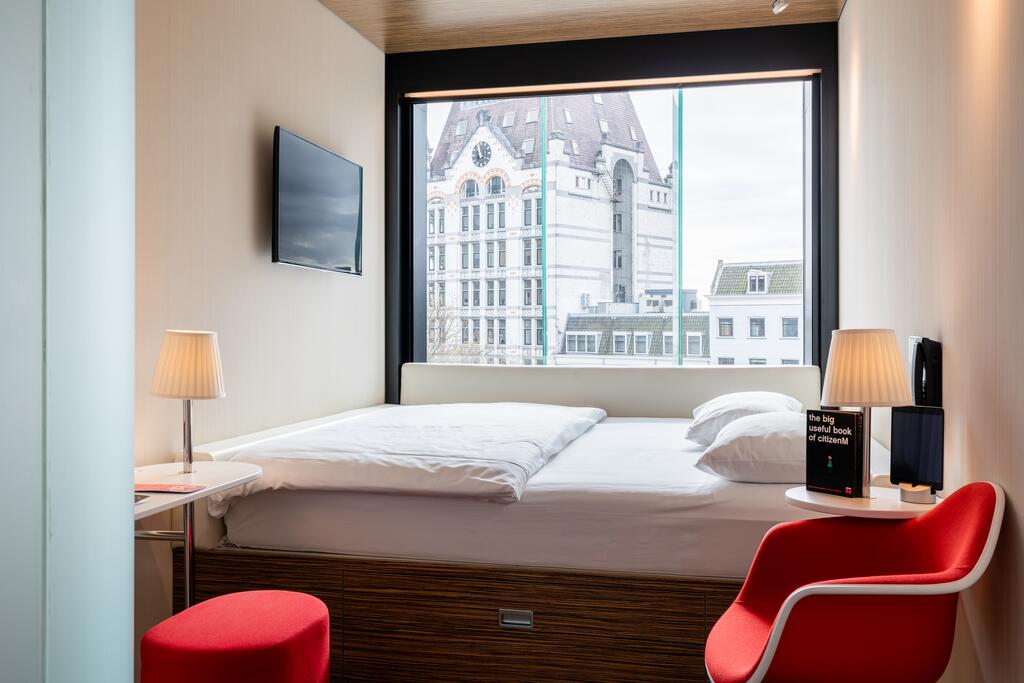
citizenM Rotterdam:
www.citizenM.com/ART2022
Special price: discount of 11% per room per night / king-size bed, including breakfast for 2 persons, VAT, excluding city tax.
Supernova Hotel:
www.supernovahotel.nl
Enter ‘ART010’ as promo code for 10% discount
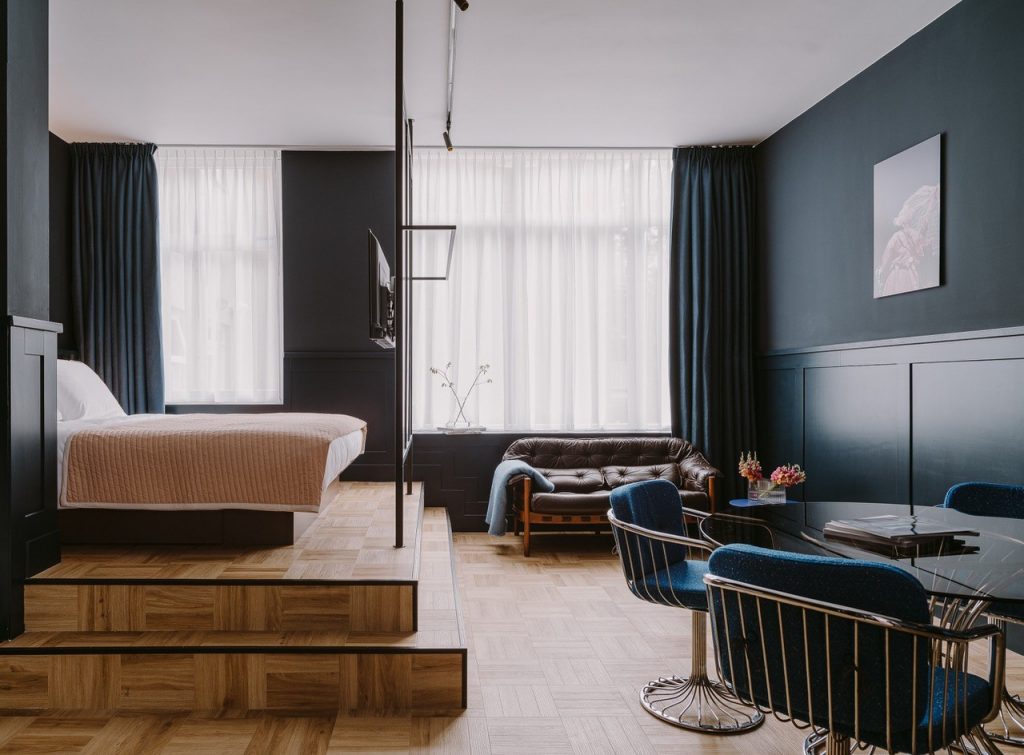
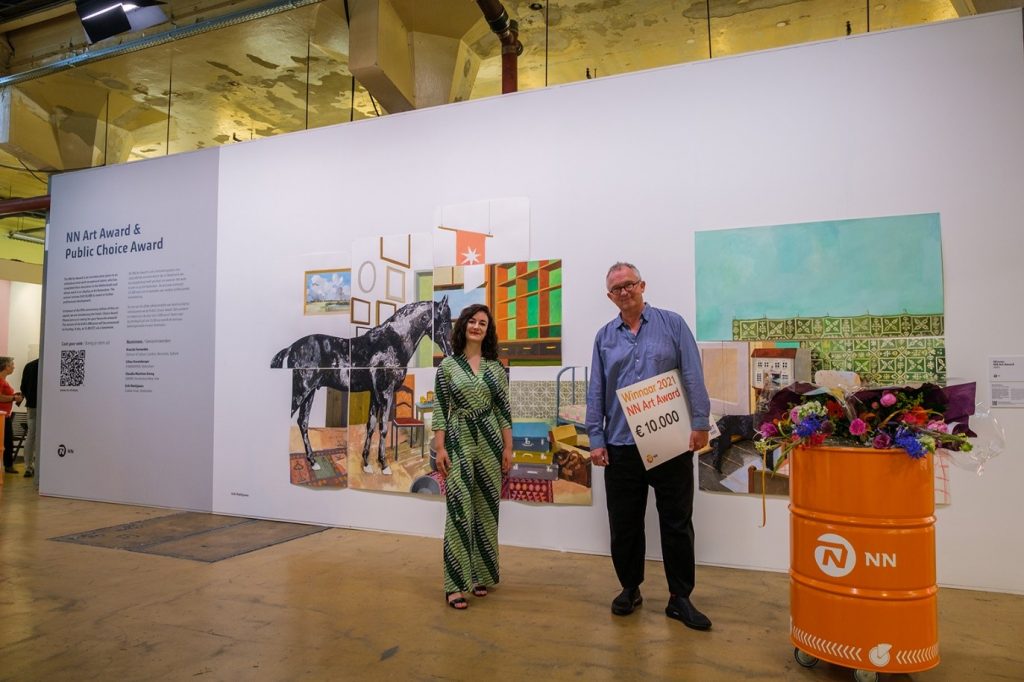
This prize is intended for artists who have completed their education at a Dutch art academy or a Dutch postgraduate institution; and their work can be seen at Art Rotterdam. The criteria: high-quality work, an interesting artistic position and adequate technical execution; authenticity and innovation (with a personal visual language); new perspectives on the world we live in and connection with/source of inspiration for the public. The selection criteria are multi-disciplinary: all media are eligible. The jury for 2022 consists of Yuki Kho, culture journalist; Alexandra Landré, artistic director Stroom, The Hague; Charl Landvreugd, head of research & curatorial practice, Stedelijk Museum Amsterdam; Erik Mattijssen, visual artist and winner of the NN Art Award 2021; Elisah van den Bergh, advisor NN Art Collection. The four nominees will be announced in mid-December 2021. The winner will receive a cash prize of €10,000. In addition, NN Group will purchase one or more works from the four nominees for its corporate collection.
NN Audience Award
The public can also vote online for one of the four nominees via the Nationale-Nederlanden website from mid-January to midnight on Saturday 12 February. The public is also welcome to vote during the exhibition days from Wednesday 9 to Saturday 12 February at the NN Art Award stand. The public favourite will receive a cash prize of €5,000. The winner of the NN Public Choice Award 2022 will be announced online on the closing day of the fair, Sunday 13 February, at 3:00 PM.
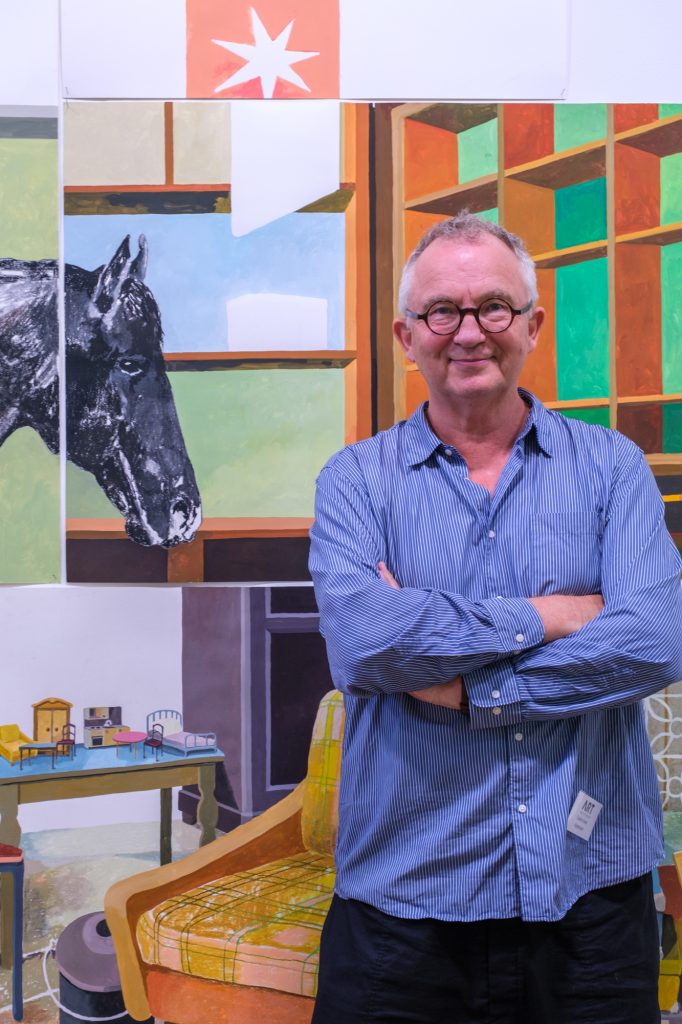
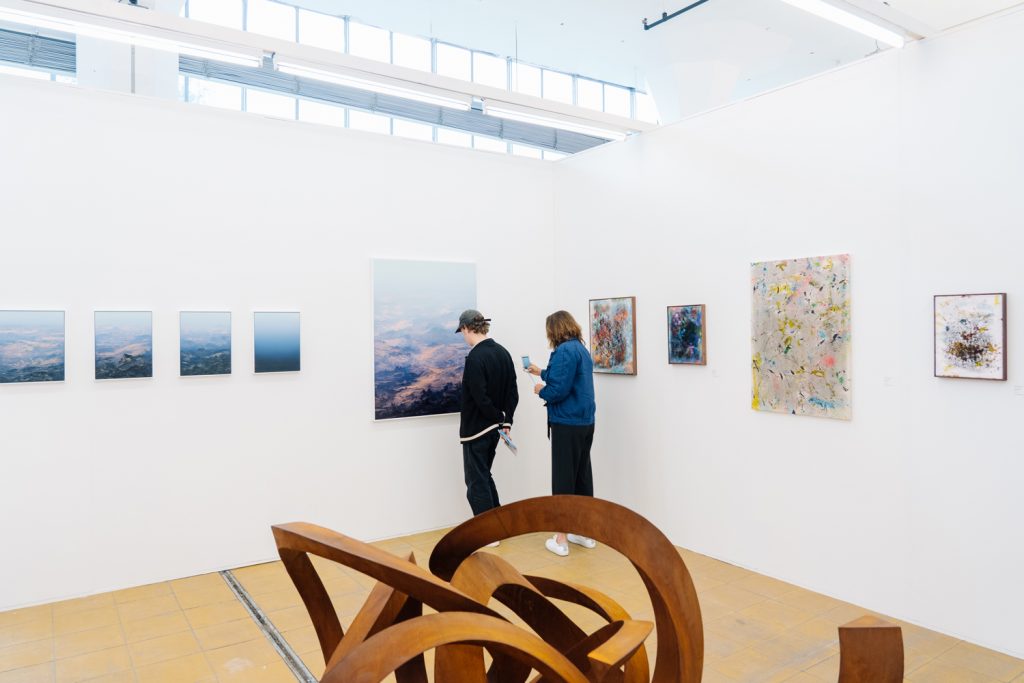
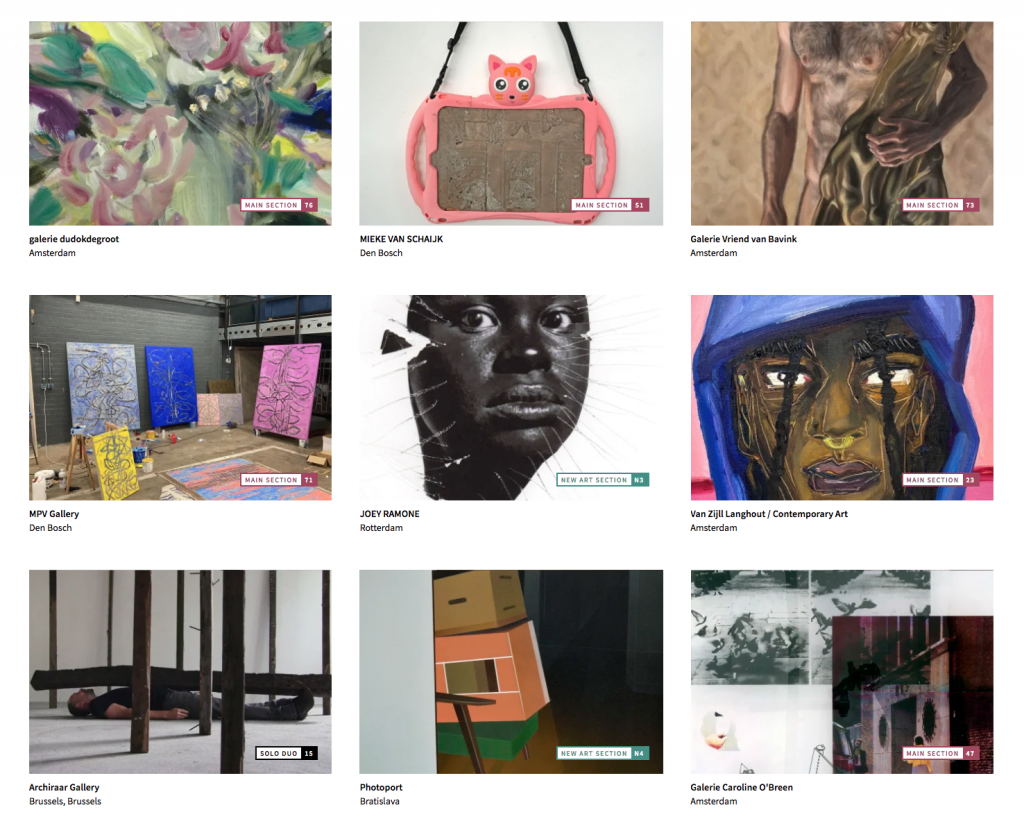
You can find the online catalogue at: GalleryViewer.com
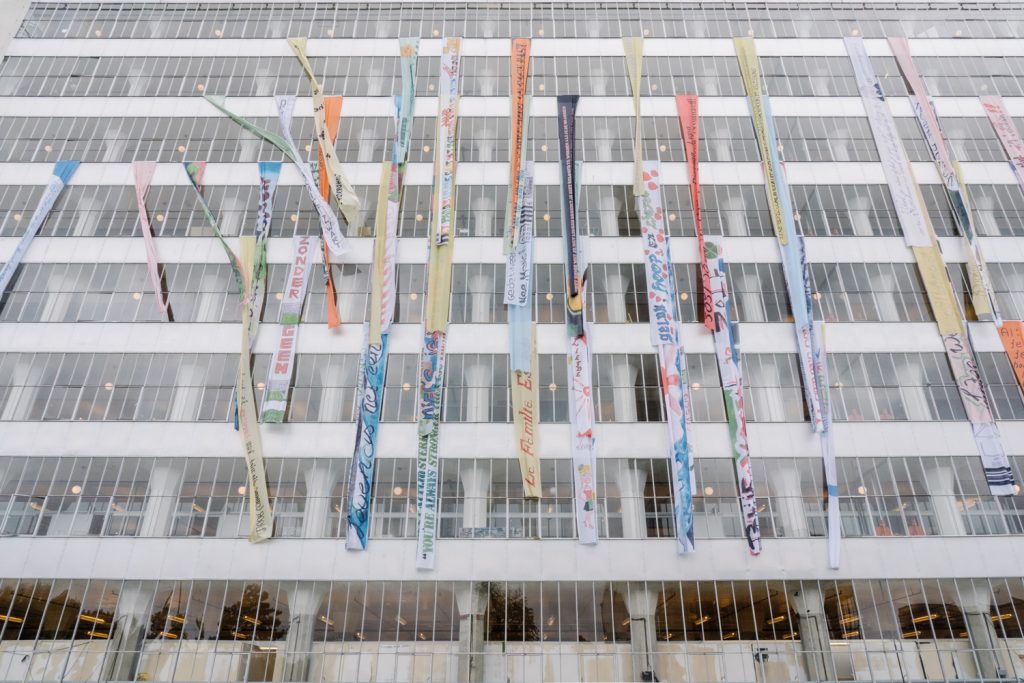
Art Rotterdam 2021 took full advantage of the summer season, with leading galleries and project spaces presenting a record number of impressive outdoor works of art on the factory grounds. Here you can read all about it:
Frank Taal | Bram Braam
100 years after Duchamp, artists continue to engage with reality and the redefinition of perspectives on current sculptural conceptions of time.
Our current state of social distance redefines our use of public space. To what extent can contemporary public space serve as an autonomous platform for interaction? Not only in spoken form, but also in textual or image-based compositions?
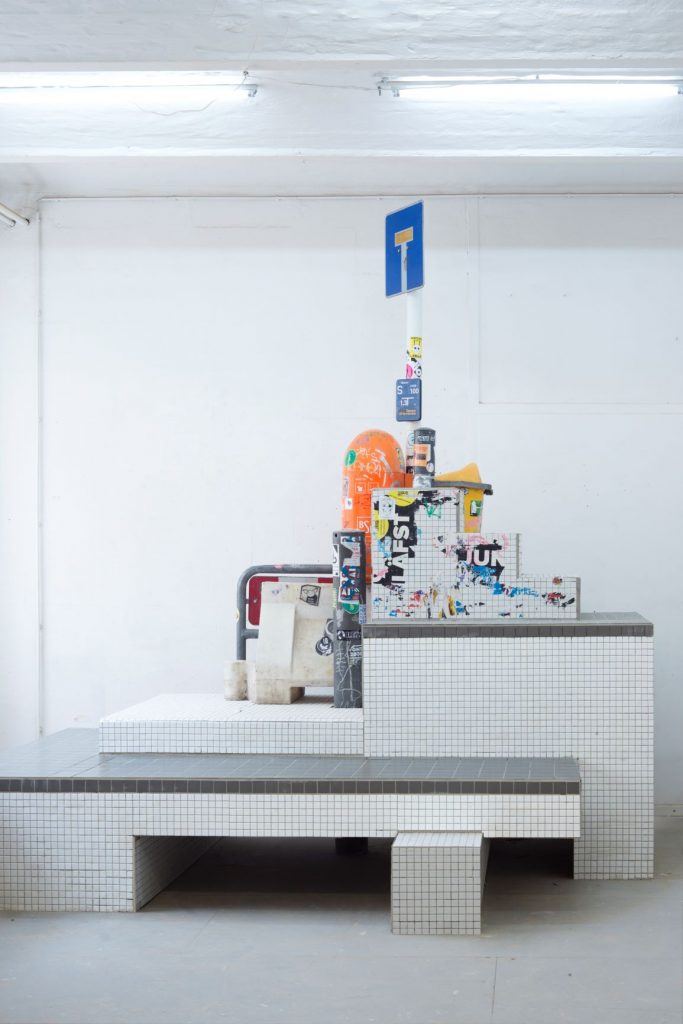
NEST | Brook Andrew
The bunyip is a mythical being in Wiradjuri (Australian) culture. This representation of bunyip is in the shape of a cartoon-like face, with eyes, saying ‘ngaay’, meaning ‘see’ in Wiradjuri language, and mouth saying ‘gir- nya- la-nha’, meaning ‘talk’. On the other side, the word ‘wiray’ means ‘no’. The artist is emphasizing that if we do not speak up for what we believe in there will be ‘wiray’ action.
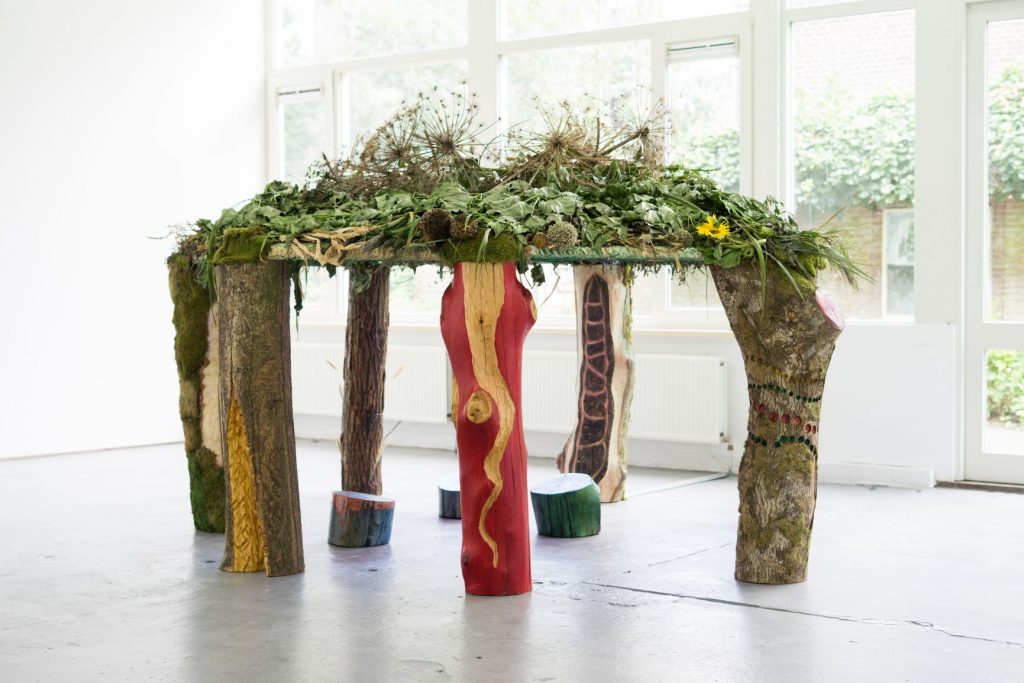
NEST | Müge Yilmaz
A Garden of Coincidences is inspired by the oldest known temple complex in the world, and according to experts, the first cult site as well, where ritual gatherings took place to honour ancestors. Yilmaz’ installation has a similar form where each pillar represents a recent ancestor from different cultures and parts of the world. Yilmaz doesn’t refer in concrete terms to people from our collective memory, but points in an abstract manner to environmental activism, the fight for freedom, feminism and philosophies of First Nation communities relating to nature.
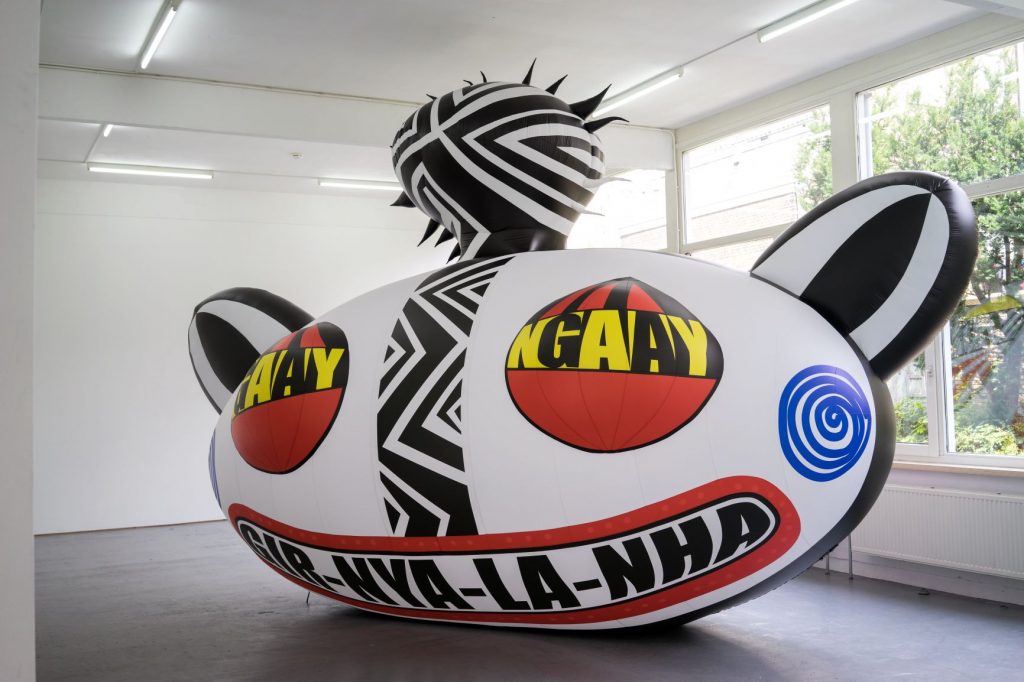
Trendbeheer | Marcha van den Hurk
Site-specific art installation by Marcha van den Hurk. Waving flags are hanging out of the windows of the Van Nelle Factory with texts from inmates from the penitentiary De Schie. The flags include quotes, slogans, wishes and messages to loved ones. When the wind blows, it is as if the flags wave at the inmates in the penitentiary across the water.
Wave has been supported by CBK Rotterdam (Centre for Visual Arts Rotterdam), Rotterdam Art Week/Rotterdam Festivals and Droom en Daad Foundation.
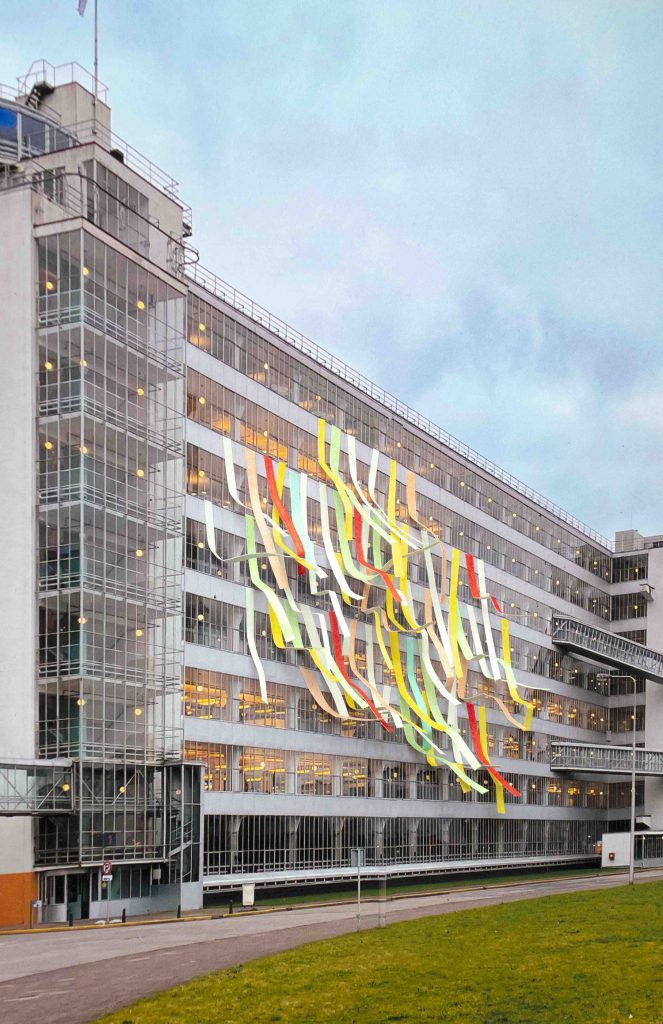
Mondriaan Fonds | Lucas Sloot
Lucas Sloot (1988) is concerned with the connections between himself and the things that surround him. His works ask us to re-examine the potential and limitations of things. Follow the Line // Crossing the Field (2020) comprises two wooden copies of an electricity pylon, an object that is found in every landscape but which we hardly notice anymore. One of the two pylons is on the lawn in front of the Van Nelle Factory, the other is inside in one of the exhibition spaces of Prospects.
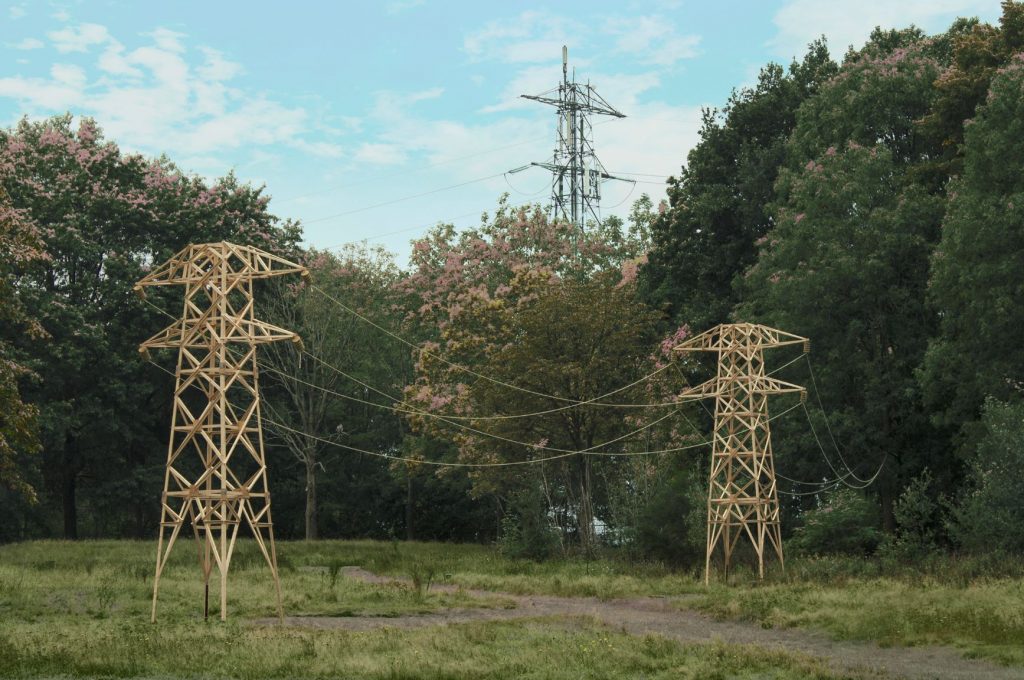
Mondriaan Fonds | Olle Stjerne
Olle Stjerne (1984) has placed a number of temporary structures in the grounds of the Van Nelle Factory. His works attempt to subvert how the viewer experiences materials. The relationship to architecture is also a recurring theme: ‘I introduce the human size right next to monumental architecture’, says the artist. ‘I am inspired by how ideas shift over time and how the past can resonate in the present.’
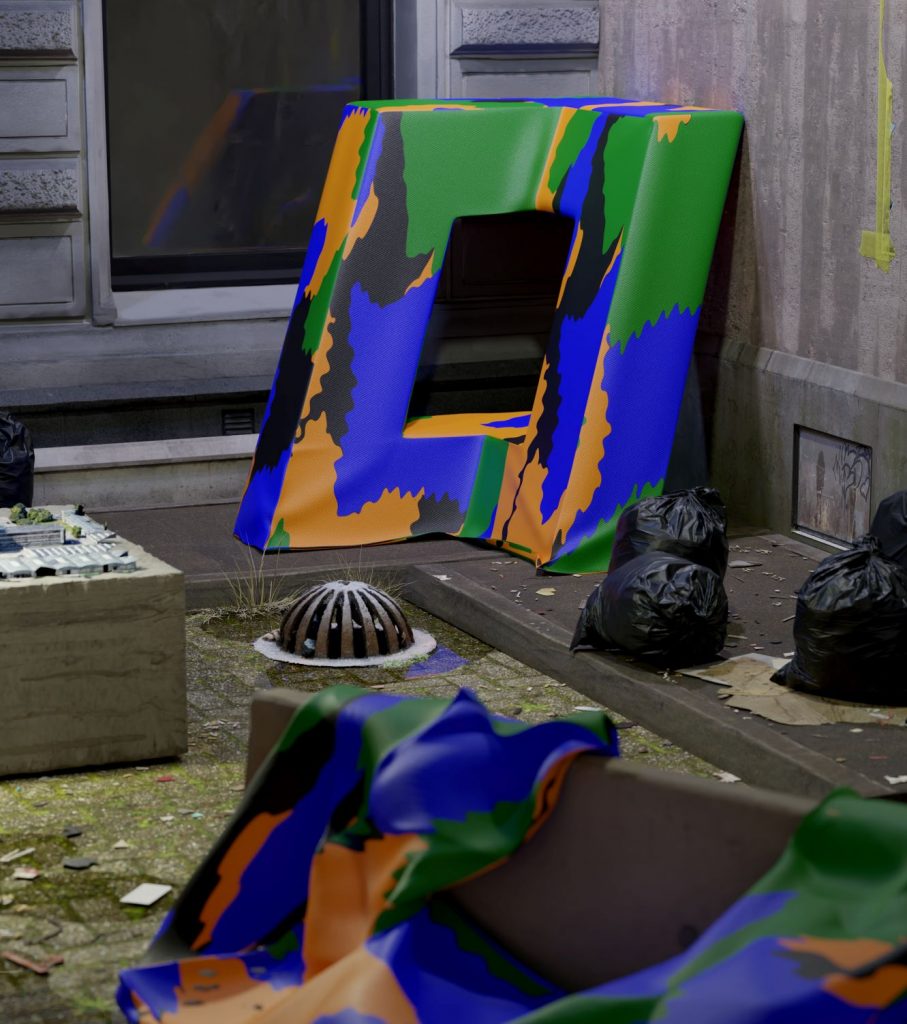
Mondriaan Fonds | Rowan van As
Rowan van As (1991) spent several months building a copy of the iconic New York taxi. For him, constructing the car was a repetitive experience, accompanied by the almost continuous soundtrack of an old album by Gil Scott-Heron and Brian Jackson. While working on the sculpture, he imagined driving his own taxi through New York and observing the social issues that Scott-Heron sings about, which are still relevant today. During Art Rotterdam, Van As’s taxi will be parked outside the Van Nelle Factory and the artist will create an atmosphere around the vehicle that matches the themes that occupied him during its construction.
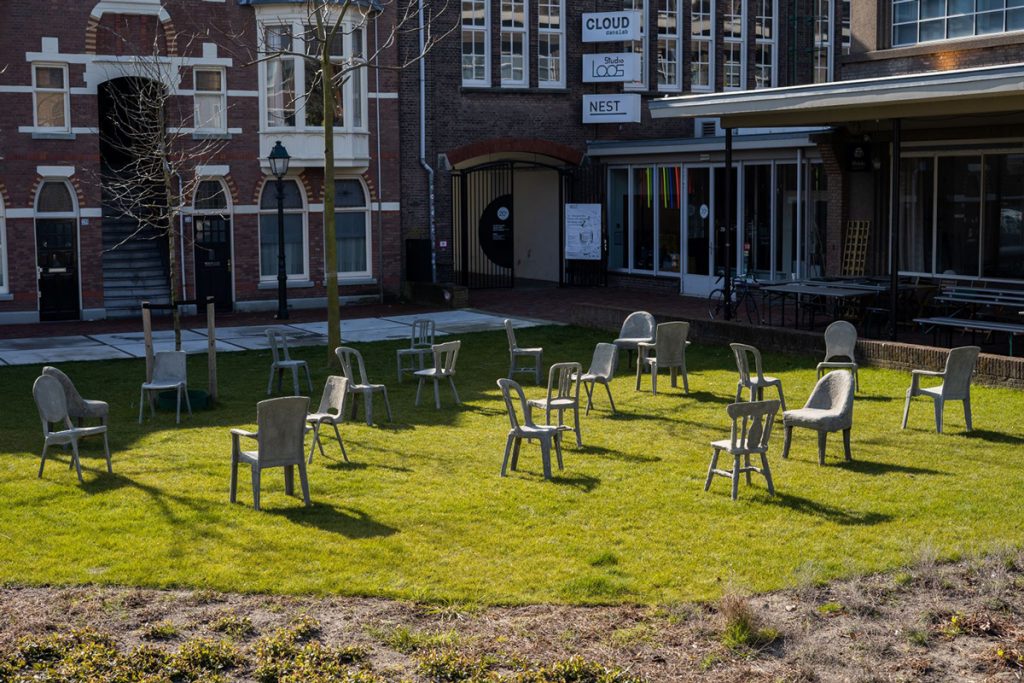
Mondriaan Fonds | Lin Gerritse
Lin Gerritse (1988) is fascinated by the human body, especially his own. His works include installations with materials that in no way resemble the body, but which function as ‘ecosystems in miniature, in which every movement influences the rest, and each individual object waits for the moment of its action’. This also applies to his sound installation of rocks being moved along and between conveyor belts, in which the sounds of falling, sliding and breaking form an endless and hypnotic musical composition. The debris derives from the Koninklijk Museum voor Schone Kunsten Antwerpen.
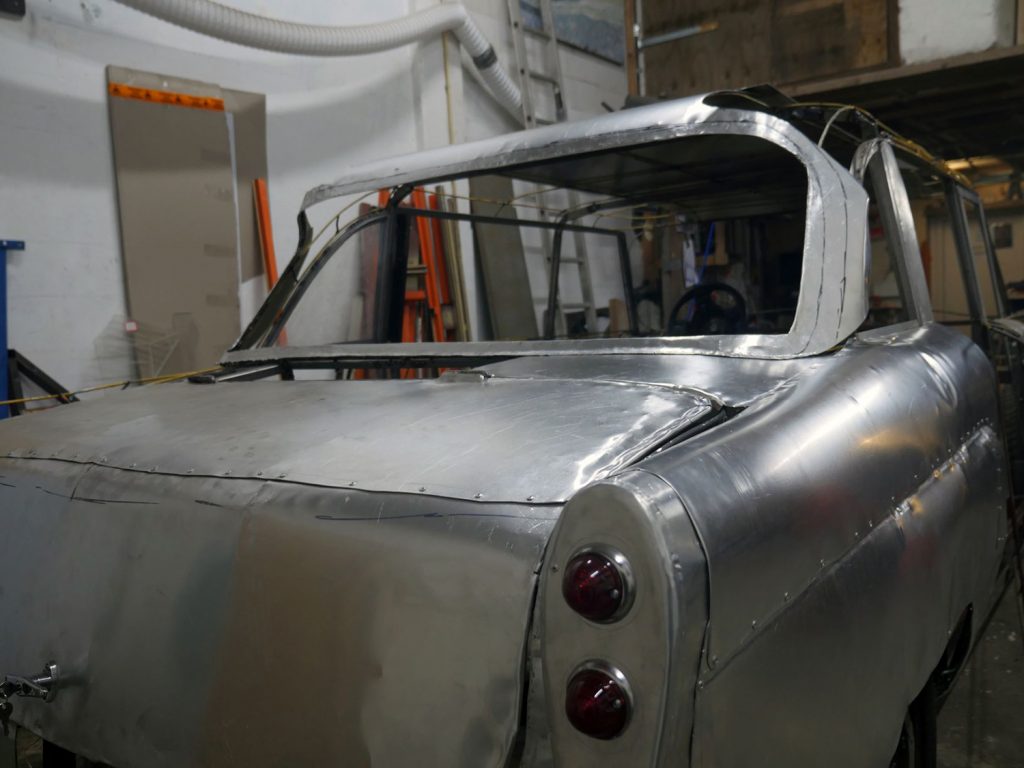
Mondriaan Fonds | Lin Gerritse
Lin Gerritse (1988) is fascinated by the human body, especially his own. His works include installations with materials that in no way resemble the body, but which function as ‘ecosystems in miniature, in which every movement influences the rest, and each individual object waits for the moment of its action’. This also applies to his sound installation of rocks being moved along and between conveyor belts, in which the sounds of falling, sliding and breaking form an endless and hypnotic musical composition. The debris derives from the Koninklijk Museum voor Schone Kunsten Antwerpen.
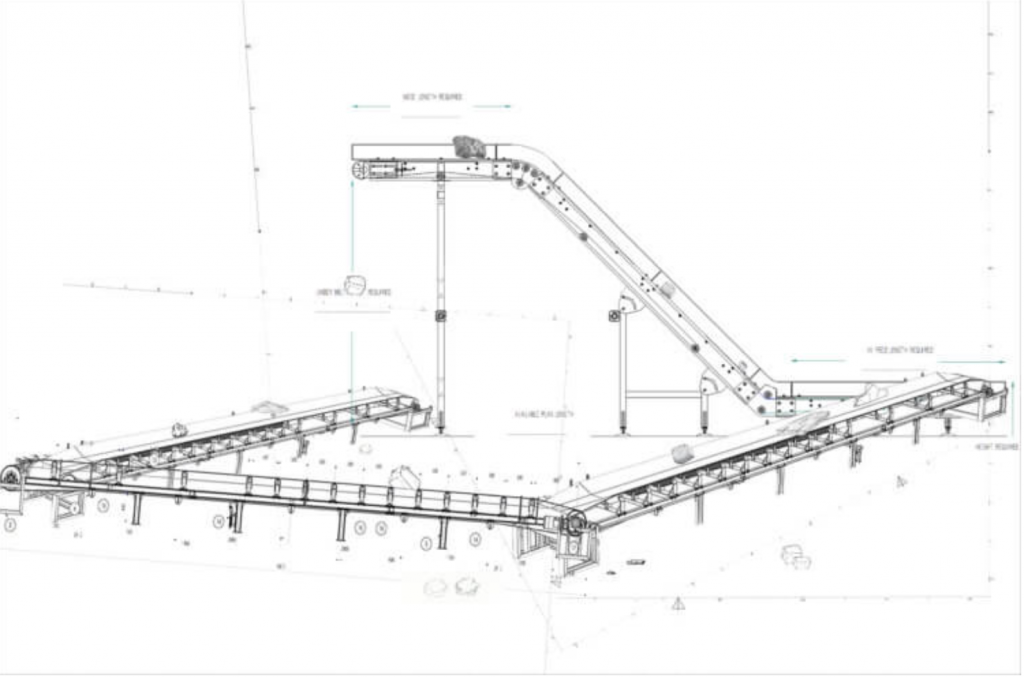
Murals Inc. | Niels Shoe Meulman
My intention is to create a memorial piece for the millions of culled/killed mink through my repetitive un-stroke style. The work will consist of 100 x 20 strokes. One stroke stands for ten thousand coronas killed minks.
Part of project ‘Are we safe now?’
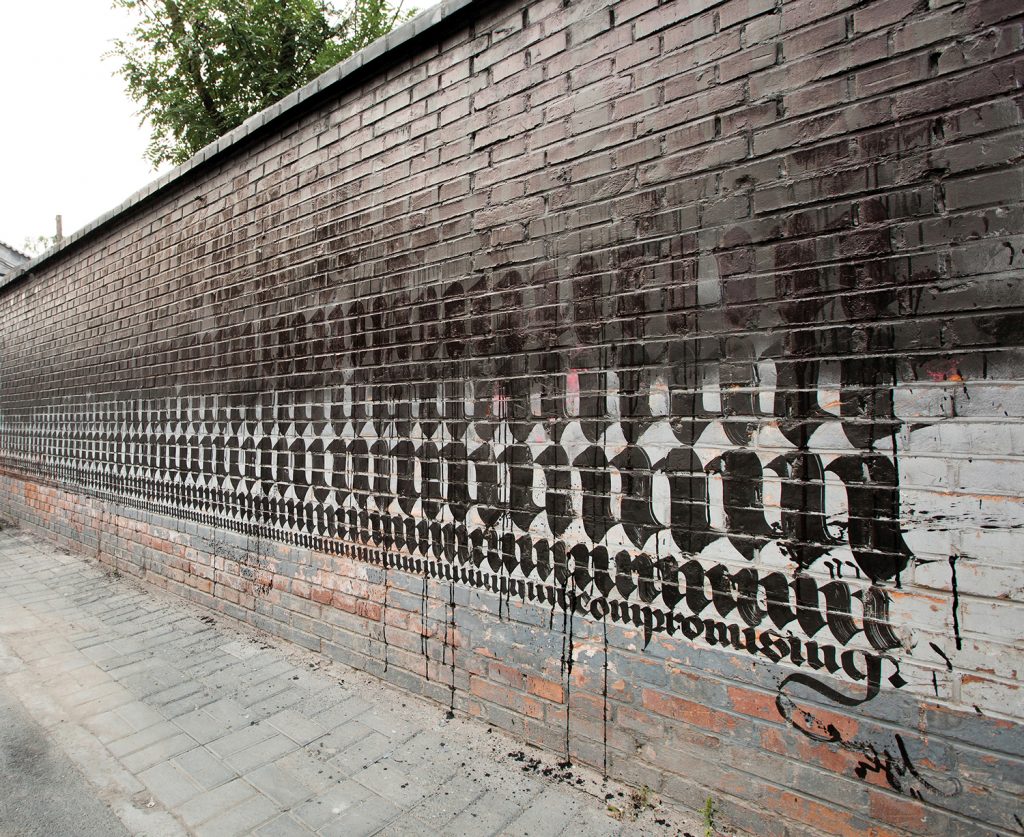
Murals Inc. | Willehad Eilers
“I intend to visualize the confusion, fear, anger, hope, opportunism, corrupcy and companionship that i experienced throughout the past year and a half of pandemic”.
Part of project ‘Are we safe now?’
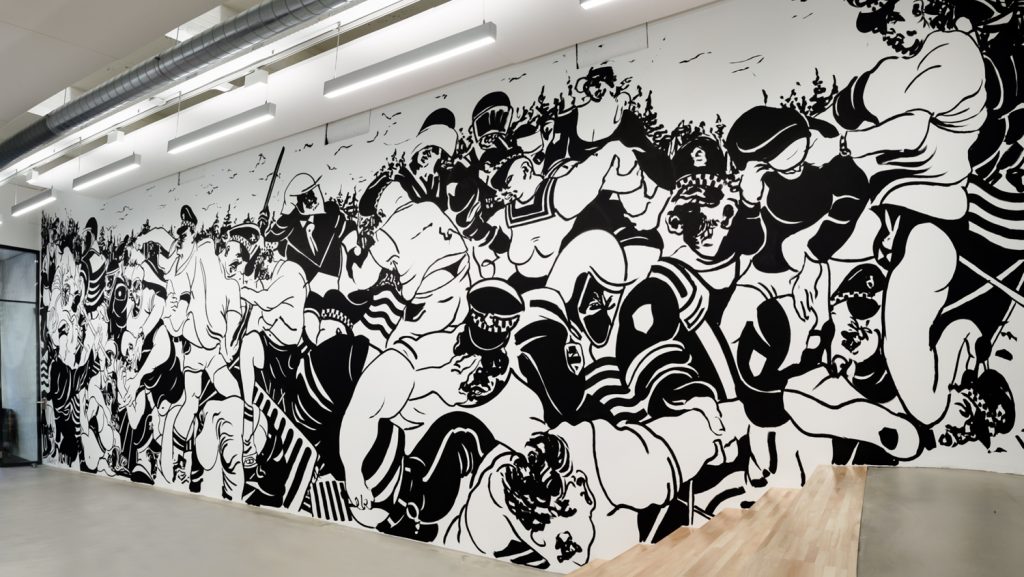
Murals Inc. | Anan Striker
‘Armed with the J-card and a ravers fan, walking on letters of value with a running nose, desiring to the ‘Return of the Real’. For real.’
(Location: Schuttevaerweg, aan de straat, bij entree Van Nellefabriek)
Part of ‘(real) humans’ bij Murals Inc. (office), Piekstraat 31
Courtesy the artists and Murals Inc., Rotterdam
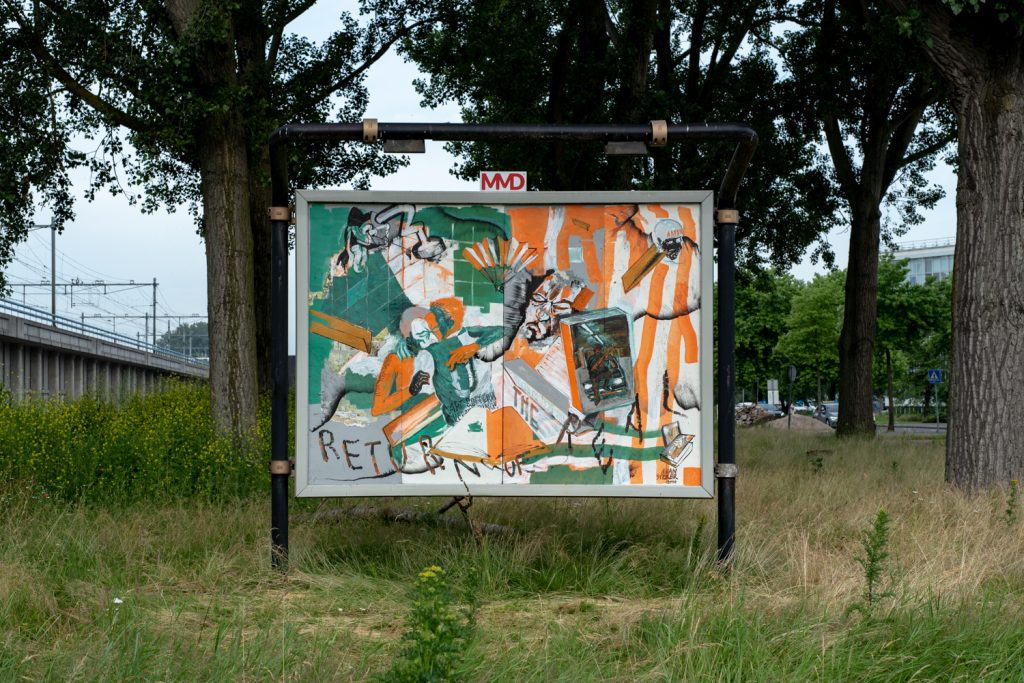
Creative Chef Studio | Jasper Udink ten Cate
This sculpture is an architectonic model from the Future Food City. A utopian city created by artist Jasper Udink ten Cate. In this city humankind solved all of the problems we are facing today by redefining the food system and our western economy. Currently the city is being built on a digital platform and has welcomed its first citizens all-ready. With the sculpture the artist wants to create a starting-point for a collective story towards a better future.
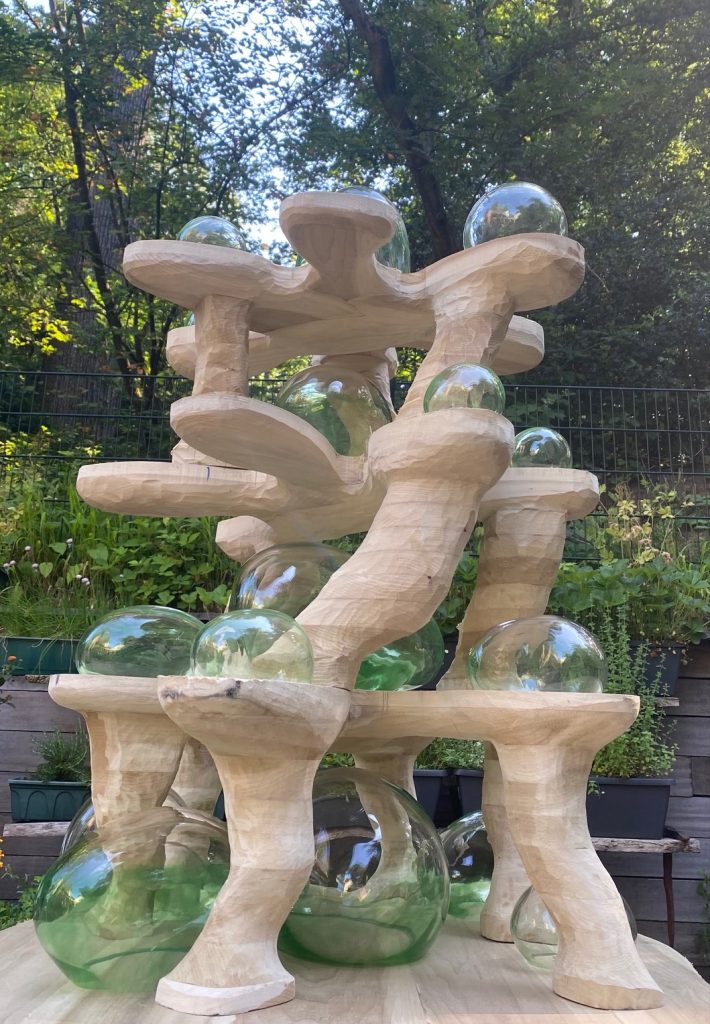
KochxBos Gallery | Sarah Maple
This installation depicts a billboard reading ‘The World As We Know It’ discharged in a skip. Initially made as a response to the UK’s departure from the EU, now adapted and changed as the political climate does. And now it’s urgent again with the global pandemic, this piece could not be more relevant. Much like the pandemic, it asks the viewer to discard what they know, reimagine the future and rethink individualism. The towering scale allows the viewer to see themselves as a smaller part in a larger narrative.
The work has previously been shown at Skip Gallery, London and has now been brought to the Netherlands by KochxBos Gallery for Art Rotterdam, also as an announcement for the new exhibition of Sarah Maple in the gallery, during the Opening of the gallery season in early September.
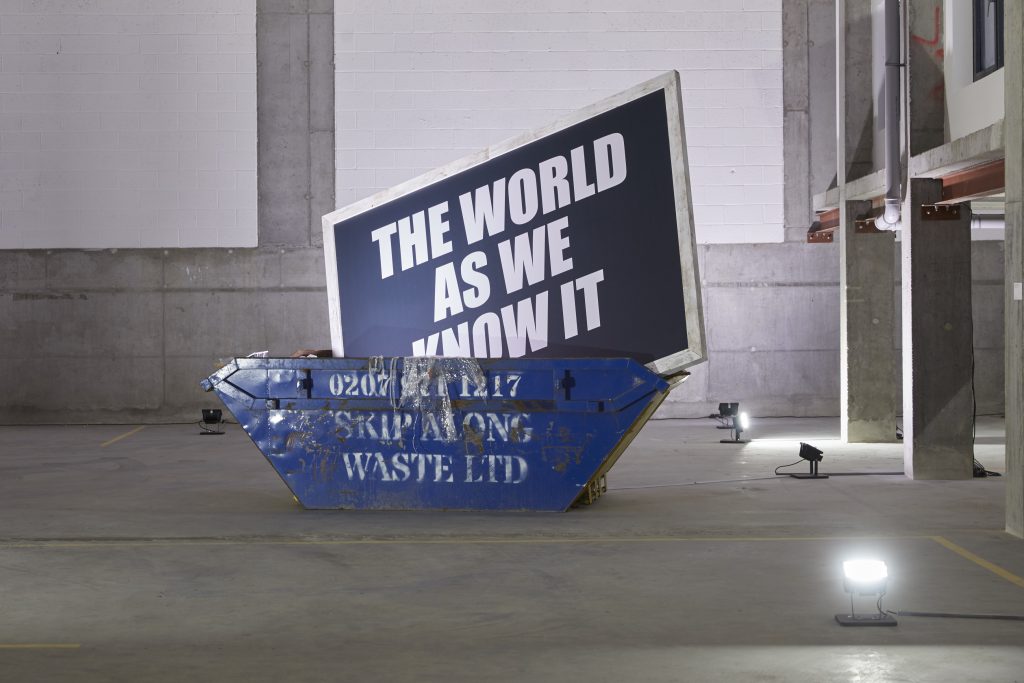
KersGallery | David Bade
The sculpture is a basis for fight or flight. A fight-orflight response, or flight-or-fight response, it is a defense mechanism that occurs in humans and animals when there is an imminent threat of danger. You could also interpret it as fighting against yourself or against prejudice. Bade always fights positively.
